Accounting: Trial Balance, Matching Concept, Conceptual Framework, Credit Cards and Bad Debts
VerifiedAdded on 2023/06/13
|25
|5001
|146
AI Summary
This article covers topics such as trial balance, matching concept, conceptual framework, credit cards and bad debts in accounting. It includes explanations, examples, and journal entries.
Contribute Materials
Your contribution can guide someone’s learning journey. Share your
documents today.

Running head: ACCOUNTING
Accounting
Name of the Student:
Name of the University:
Author’s Note:
Accounting
Name of the Student:
Name of the University:
Author’s Note:
Secure Best Marks with AI Grader
Need help grading? Try our AI Grader for instant feedback on your assignments.

1
ACCOUNTING
Table of Contents
Question 1........................................................................................................................................3
Requirement A.............................................................................................................................3
Requirement B.............................................................................................................................4
Question 2........................................................................................................................................4
Requirement A.............................................................................................................................4
Requirement B.............................................................................................................................5
Question 3........................................................................................................................................7
Requirement A.............................................................................................................................7
Requirement B.............................................................................................................................8
Question 4......................................................................................................................................10
Requirement A...........................................................................................................................10
Requirement B...........................................................................................................................11
Question 5......................................................................................................................................15
Requirement A...........................................................................................................................15
Requirement B – Journal Entries...............................................................................................18
Journal Entries...........................................................................................................................19
Question 6......................................................................................................................................20
Requirement A...........................................................................................................................20
Requirement B...........................................................................................................................23
ACCOUNTING
Table of Contents
Question 1........................................................................................................................................3
Requirement A.............................................................................................................................3
Requirement B.............................................................................................................................4
Question 2........................................................................................................................................4
Requirement A.............................................................................................................................4
Requirement B.............................................................................................................................5
Question 3........................................................................................................................................7
Requirement A.............................................................................................................................7
Requirement B.............................................................................................................................8
Question 4......................................................................................................................................10
Requirement A...........................................................................................................................10
Requirement B...........................................................................................................................11
Question 5......................................................................................................................................15
Requirement A...........................................................................................................................15
Requirement B – Journal Entries...............................................................................................18
Journal Entries...........................................................................................................................19
Question 6......................................................................................................................................20
Requirement A...........................................................................................................................20
Requirement B...........................................................................................................................23

2
ACCOUNTING
Reference.......................................................................................................................................24
ACCOUNTING
Reference.......................................................................................................................................24
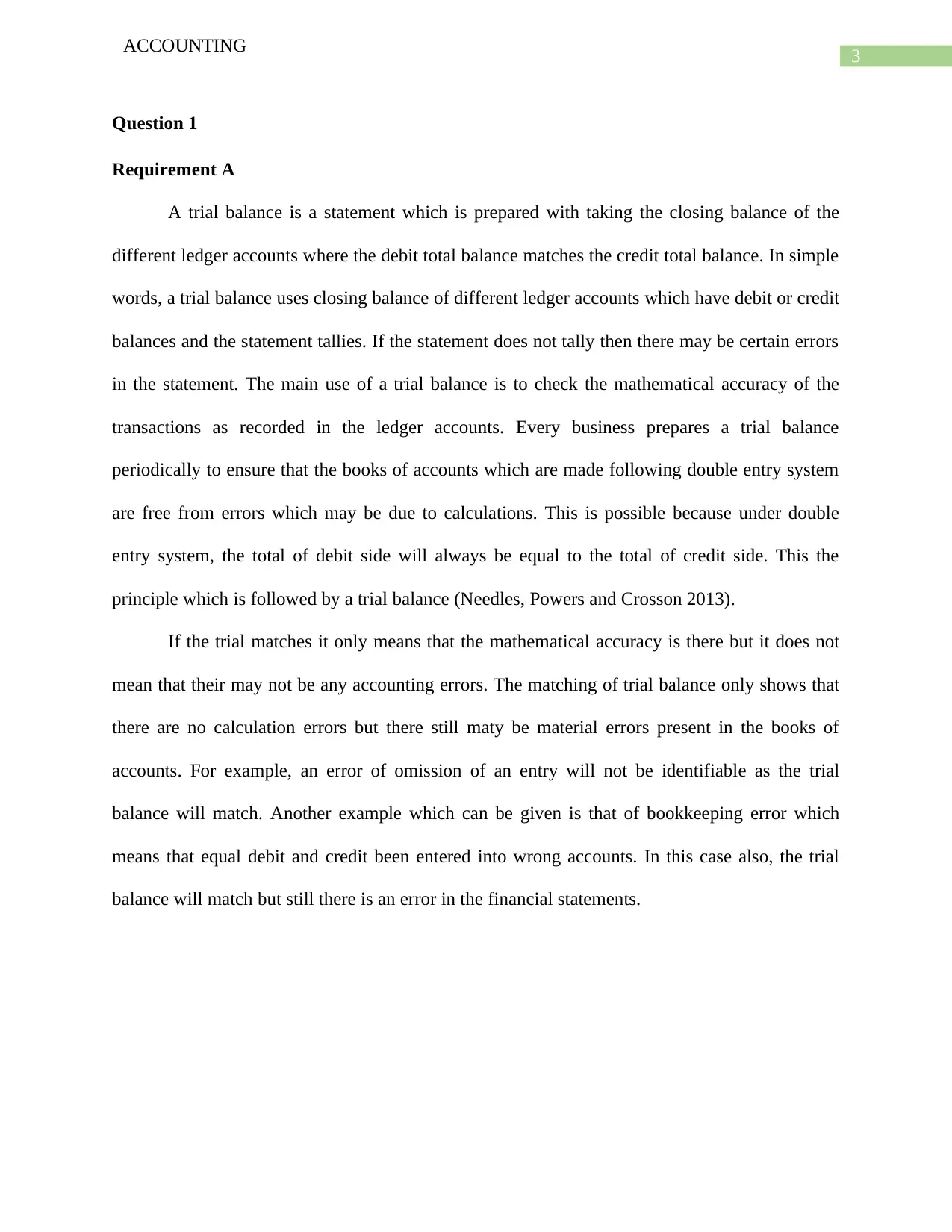
3
ACCOUNTING
Question 1
Requirement A
A trial balance is a statement which is prepared with taking the closing balance of the
different ledger accounts where the debit total balance matches the credit total balance. In simple
words, a trial balance uses closing balance of different ledger accounts which have debit or credit
balances and the statement tallies. If the statement does not tally then there may be certain errors
in the statement. The main use of a trial balance is to check the mathematical accuracy of the
transactions as recorded in the ledger accounts. Every business prepares a trial balance
periodically to ensure that the books of accounts which are made following double entry system
are free from errors which may be due to calculations. This is possible because under double
entry system, the total of debit side will always be equal to the total of credit side. This the
principle which is followed by a trial balance (Needles, Powers and Crosson 2013).
If the trial matches it only means that the mathematical accuracy is there but it does not
mean that their may not be any accounting errors. The matching of trial balance only shows that
there are no calculation errors but there still maty be material errors present in the books of
accounts. For example, an error of omission of an entry will not be identifiable as the trial
balance will match. Another example which can be given is that of bookkeeping error which
means that equal debit and credit been entered into wrong accounts. In this case also, the trial
balance will match but still there is an error in the financial statements.
ACCOUNTING
Question 1
Requirement A
A trial balance is a statement which is prepared with taking the closing balance of the
different ledger accounts where the debit total balance matches the credit total balance. In simple
words, a trial balance uses closing balance of different ledger accounts which have debit or credit
balances and the statement tallies. If the statement does not tally then there may be certain errors
in the statement. The main use of a trial balance is to check the mathematical accuracy of the
transactions as recorded in the ledger accounts. Every business prepares a trial balance
periodically to ensure that the books of accounts which are made following double entry system
are free from errors which may be due to calculations. This is possible because under double
entry system, the total of debit side will always be equal to the total of credit side. This the
principle which is followed by a trial balance (Needles, Powers and Crosson 2013).
If the trial matches it only means that the mathematical accuracy is there but it does not
mean that their may not be any accounting errors. The matching of trial balance only shows that
there are no calculation errors but there still maty be material errors present in the books of
accounts. For example, an error of omission of an entry will not be identifiable as the trial
balance will match. Another example which can be given is that of bookkeeping error which
means that equal debit and credit been entered into wrong accounts. In this case also, the trial
balance will match but still there is an error in the financial statements.
Secure Best Marks with AI Grader
Need help grading? Try our AI Grader for instant feedback on your assignments.
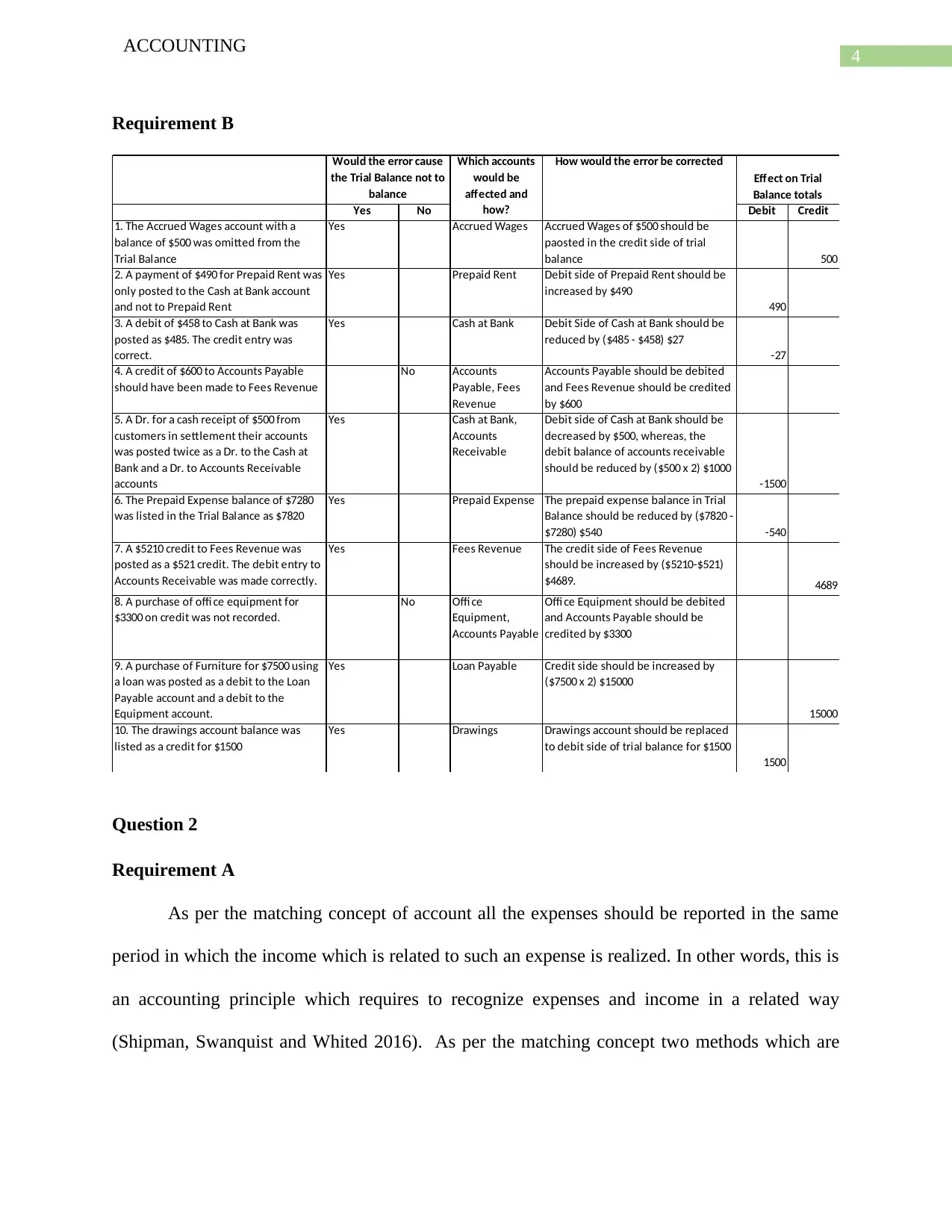
4
ACCOUNTING
Requirement B
Yes No Debit Credit
1. The Accrued Wages account with a
balance of $500 was omitted from the
Trial Balance
Yes Accrued Wages Accrued Wages of $500 should be
paosted in the credit side of trial
balance 500
2. A payment of $490 for Prepaid Rent was
only posted to the Cash at Bank account
and not to Prepaid Rent
Yes Prepaid Rent Debit side of Prepaid Rent should be
increased by $490
490
3. A debit of $458 to Cash at Bank was
posted as $485. The credit entry was
correct.
Yes Cash at Bank Debit Side of Cash at Bank should be
reduced by ($485 - $458) $27
-27
4. A credit of $600 to Accounts Payable
should have been made to Fees Revenue
No Accounts
Payable, Fees
Revenue
Accounts Payable should be debited
and Fees Revenue should be credited
by $600
5. A Dr. for a cash receipt of $500 from
customers in settlement their accounts
was posted twice as a Dr. to the Cash at
Bank and a Dr. to Accounts Receivable
accounts
Yes Cash at Bank,
Accounts
Receivable
Debit side of Cash at Bank should be
decreased by $500, whereas, the
debit balance of accounts receivable
should be reduced by ($500 x 2) $1000
-1500
6. The Prepaid Expense balance of $7280
was listed in the Trial Balance as $7820
Yes Prepaid Expense The prepaid expense balance in Trial
Balance should be reduced by ($7820 -
$7280) $540 -540
7. A $5210 credit to Fees Revenue was
posted as a $521 credit. The debit entry to
Accounts Receivable was made correctly.
Yes Fees Revenue The credit side of Fees Revenue
should be increased by ($5210-$521)
$4689. 4689
8. A purchase of offi ce equipment for
$3300 on credit was not recorded.
No Offi ce
Equipment,
Accounts Payable
Offi ce Equipment should be debited
and Accounts Payable should be
credited by $3300
9. A purchase of Furniture for $7500 using
a loan was posted as a debit to the Loan
Payable account and a debit to the
Equipment account.
Yes Loan Payable Credit side should be increased by
($7500 x 2) $15000
15000
10. The drawings account balance was
listed as a credit for $1500
Yes Drawings Drawings account should be replaced
to debit side of trial balance for $1500
1500
Would the error cause
the Trial Balance not to
balance
Which accounts
would be
affected and
how?
How would the error be corrected
Effect on Trial
Balance totals
Question 2
Requirement A
As per the matching concept of account all the expenses should be reported in the same
period in which the income which is related to such an expense is realized. In other words, this is
an accounting principle which requires to recognize expenses and income in a related way
(Shipman, Swanquist and Whited 2016). As per the matching concept two methods which are
ACCOUNTING
Requirement B
Yes No Debit Credit
1. The Accrued Wages account with a
balance of $500 was omitted from the
Trial Balance
Yes Accrued Wages Accrued Wages of $500 should be
paosted in the credit side of trial
balance 500
2. A payment of $490 for Prepaid Rent was
only posted to the Cash at Bank account
and not to Prepaid Rent
Yes Prepaid Rent Debit side of Prepaid Rent should be
increased by $490
490
3. A debit of $458 to Cash at Bank was
posted as $485. The credit entry was
correct.
Yes Cash at Bank Debit Side of Cash at Bank should be
reduced by ($485 - $458) $27
-27
4. A credit of $600 to Accounts Payable
should have been made to Fees Revenue
No Accounts
Payable, Fees
Revenue
Accounts Payable should be debited
and Fees Revenue should be credited
by $600
5. A Dr. for a cash receipt of $500 from
customers in settlement their accounts
was posted twice as a Dr. to the Cash at
Bank and a Dr. to Accounts Receivable
accounts
Yes Cash at Bank,
Accounts
Receivable
Debit side of Cash at Bank should be
decreased by $500, whereas, the
debit balance of accounts receivable
should be reduced by ($500 x 2) $1000
-1500
6. The Prepaid Expense balance of $7280
was listed in the Trial Balance as $7820
Yes Prepaid Expense The prepaid expense balance in Trial
Balance should be reduced by ($7820 -
$7280) $540 -540
7. A $5210 credit to Fees Revenue was
posted as a $521 credit. The debit entry to
Accounts Receivable was made correctly.
Yes Fees Revenue The credit side of Fees Revenue
should be increased by ($5210-$521)
$4689. 4689
8. A purchase of offi ce equipment for
$3300 on credit was not recorded.
No Offi ce
Equipment,
Accounts Payable
Offi ce Equipment should be debited
and Accounts Payable should be
credited by $3300
9. A purchase of Furniture for $7500 using
a loan was posted as a debit to the Loan
Payable account and a debit to the
Equipment account.
Yes Loan Payable Credit side should be increased by
($7500 x 2) $15000
15000
10. The drawings account balance was
listed as a credit for $1500
Yes Drawings Drawings account should be replaced
to debit side of trial balance for $1500
1500
Would the error cause
the Trial Balance not to
balance
Which accounts
would be
affected and
how?
How would the error be corrected
Effect on Trial
Balance totals
Question 2
Requirement A
As per the matching concept of account all the expenses should be reported in the same
period in which the income which is related to such an expense is realized. In other words, this is
an accounting principle which requires to recognize expenses and income in a related way
(Shipman, Swanquist and Whited 2016). As per the matching concept two methods which are
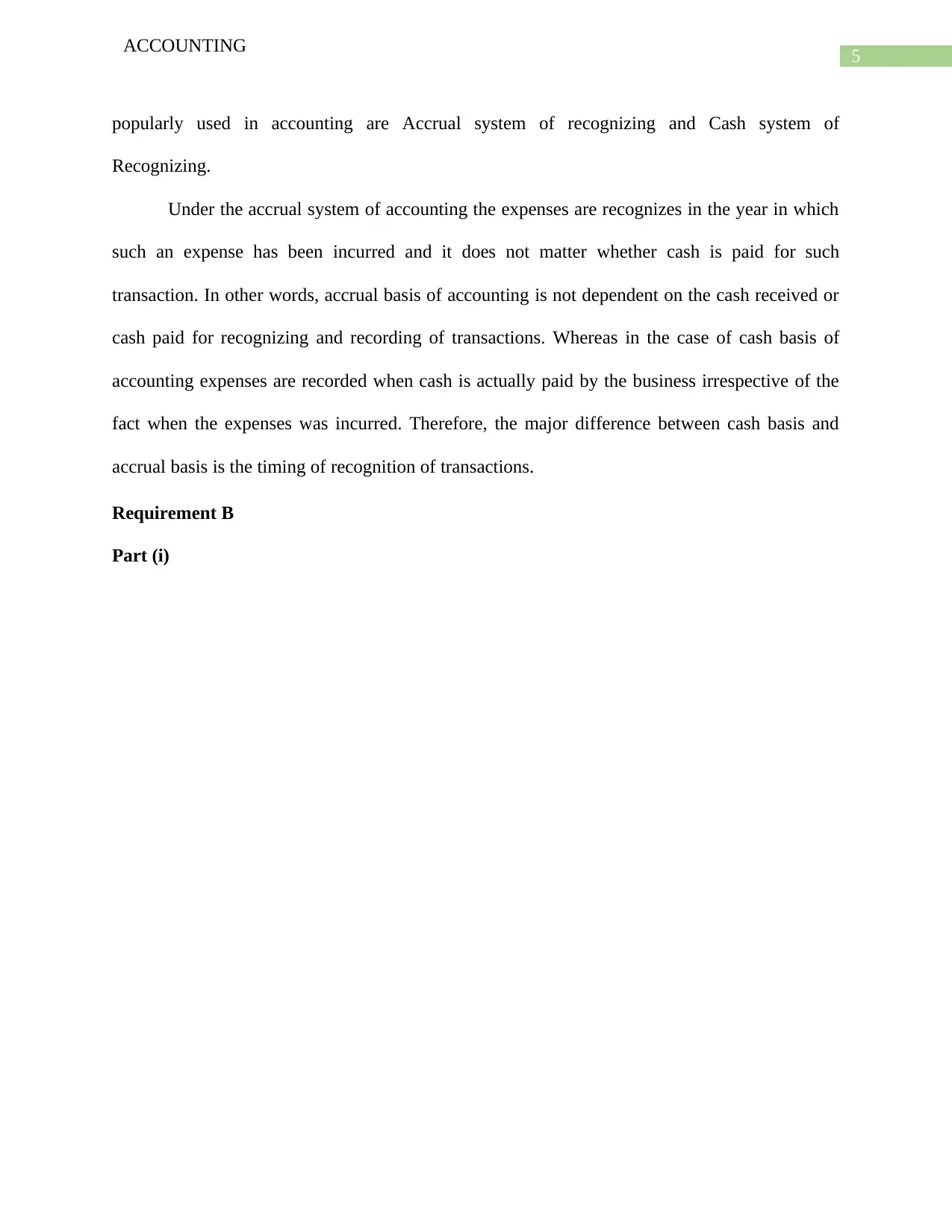
5
ACCOUNTING
popularly used in accounting are Accrual system of recognizing and Cash system of
Recognizing.
Under the accrual system of accounting the expenses are recognizes in the year in which
such an expense has been incurred and it does not matter whether cash is paid for such
transaction. In other words, accrual basis of accounting is not dependent on the cash received or
cash paid for recognizing and recording of transactions. Whereas in the case of cash basis of
accounting expenses are recorded when cash is actually paid by the business irrespective of the
fact when the expenses was incurred. Therefore, the major difference between cash basis and
accrual basis is the timing of recognition of transactions.
Requirement B
Part (i)
ACCOUNTING
popularly used in accounting are Accrual system of recognizing and Cash system of
Recognizing.
Under the accrual system of accounting the expenses are recognizes in the year in which
such an expense has been incurred and it does not matter whether cash is paid for such
transaction. In other words, accrual basis of accounting is not dependent on the cash received or
cash paid for recognizing and recording of transactions. Whereas in the case of cash basis of
accounting expenses are recorded when cash is actually paid by the business irrespective of the
fact when the expenses was incurred. Therefore, the major difference between cash basis and
accrual basis is the timing of recognition of transactions.
Requirement B
Part (i)

6
ACCOUNTING
Part (ii)
ACCOUNTING
Part (ii)
Paraphrase This Document
Need a fresh take? Get an instant paraphrase of this document with our AI Paraphraser
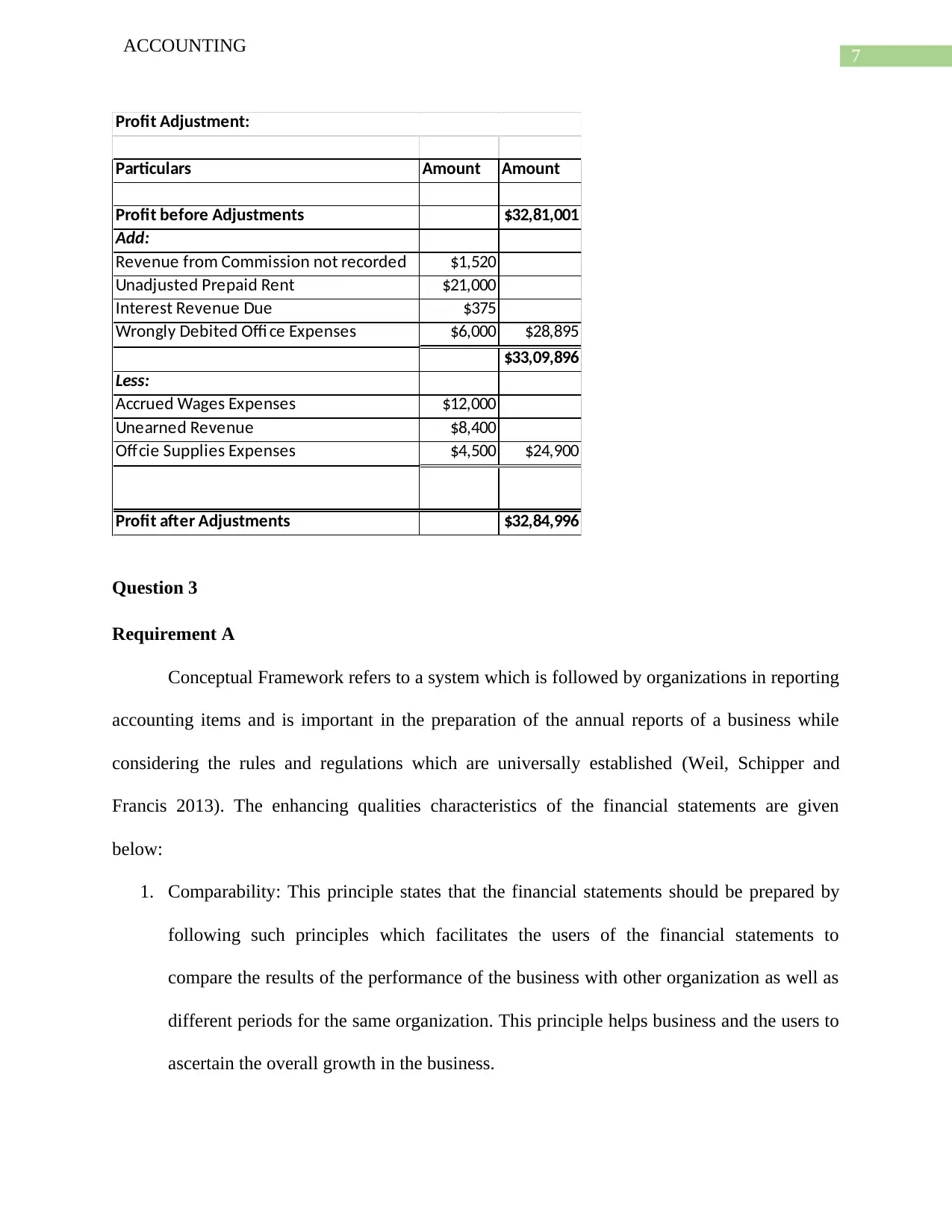
7
ACCOUNTING
Particulars Amount Amount
Profit before Adjustments $32,81,001
Add:
Revenue from Commission not recorded $1,520
Unadjusted Prepaid Rent $21,000
Interest Revenue Due $375
Wrongly Debited Offi ce Expenses $6,000 $28,895
$33,09,896
Less:
Accrued Wages Expenses $12,000
Unearned Revenue $8,400
Offcie Supplies Expenses $4,500 $24,900
Profit after Adjustments $32,84,996
Profit Adjustment:
Question 3
Requirement A
Conceptual Framework refers to a system which is followed by organizations in reporting
accounting items and is important in the preparation of the annual reports of a business while
considering the rules and regulations which are universally established (Weil, Schipper and
Francis 2013). The enhancing qualities characteristics of the financial statements are given
below:
1. Comparability: This principle states that the financial statements should be prepared by
following such principles which facilitates the users of the financial statements to
compare the results of the performance of the business with other organization as well as
different periods for the same organization. This principle helps business and the users to
ascertain the overall growth in the business.
ACCOUNTING
Particulars Amount Amount
Profit before Adjustments $32,81,001
Add:
Revenue from Commission not recorded $1,520
Unadjusted Prepaid Rent $21,000
Interest Revenue Due $375
Wrongly Debited Offi ce Expenses $6,000 $28,895
$33,09,896
Less:
Accrued Wages Expenses $12,000
Unearned Revenue $8,400
Offcie Supplies Expenses $4,500 $24,900
Profit after Adjustments $32,84,996
Profit Adjustment:
Question 3
Requirement A
Conceptual Framework refers to a system which is followed by organizations in reporting
accounting items and is important in the preparation of the annual reports of a business while
considering the rules and regulations which are universally established (Weil, Schipper and
Francis 2013). The enhancing qualities characteristics of the financial statements are given
below:
1. Comparability: This principle states that the financial statements should be prepared by
following such principles which facilitates the users of the financial statements to
compare the results of the performance of the business with other organization as well as
different periods for the same organization. This principle helps business and the users to
ascertain the overall growth in the business.
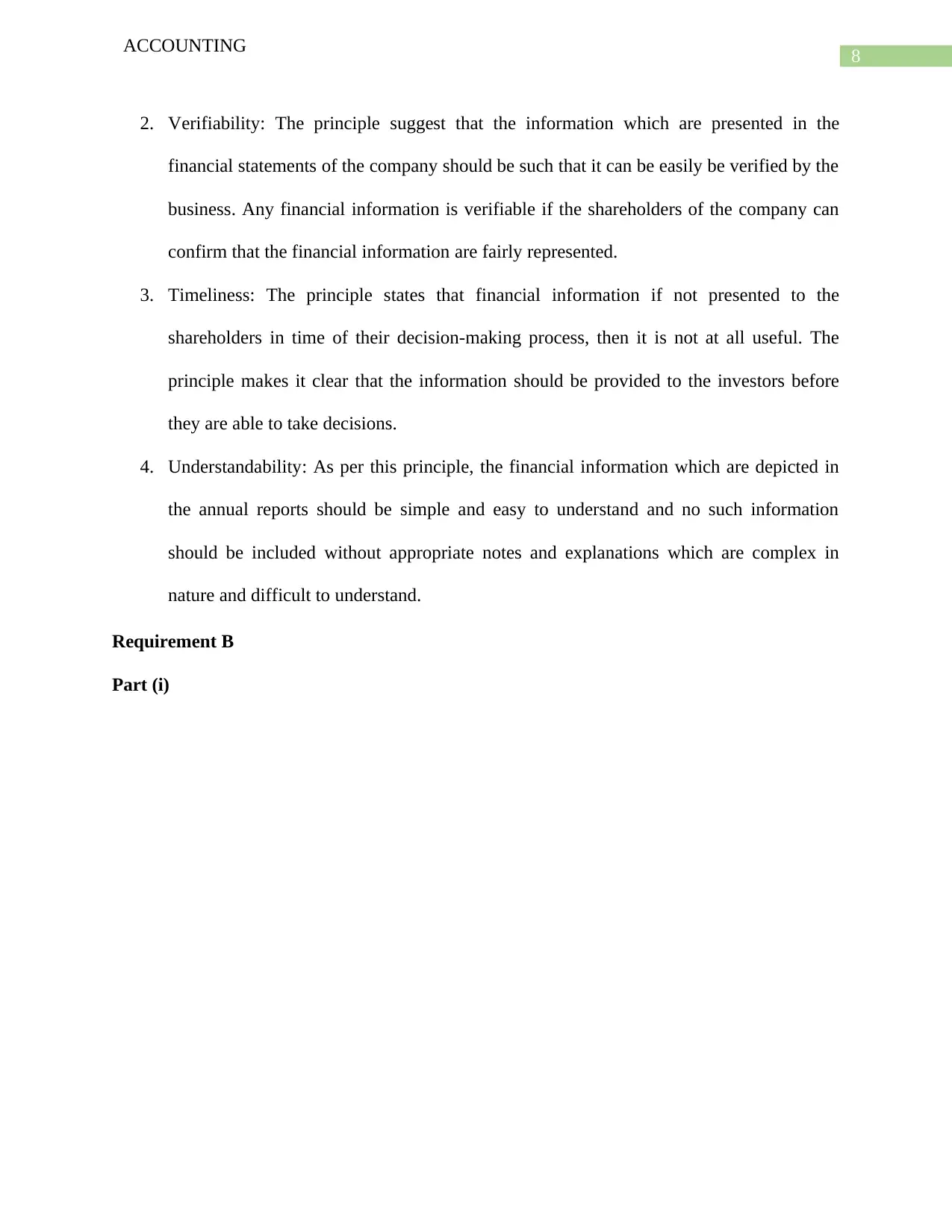
8
ACCOUNTING
2. Verifiability: The principle suggest that the information which are presented in the
financial statements of the company should be such that it can be easily be verified by the
business. Any financial information is verifiable if the shareholders of the company can
confirm that the financial information are fairly represented.
3. Timeliness: The principle states that financial information if not presented to the
shareholders in time of their decision-making process, then it is not at all useful. The
principle makes it clear that the information should be provided to the investors before
they are able to take decisions.
4. Understandability: As per this principle, the financial information which are depicted in
the annual reports should be simple and easy to understand and no such information
should be included without appropriate notes and explanations which are complex in
nature and difficult to understand.
Requirement B
Part (i)
ACCOUNTING
2. Verifiability: The principle suggest that the information which are presented in the
financial statements of the company should be such that it can be easily be verified by the
business. Any financial information is verifiable if the shareholders of the company can
confirm that the financial information are fairly represented.
3. Timeliness: The principle states that financial information if not presented to the
shareholders in time of their decision-making process, then it is not at all useful. The
principle makes it clear that the information should be provided to the investors before
they are able to take decisions.
4. Understandability: As per this principle, the financial information which are depicted in
the annual reports should be simple and easy to understand and no such information
should be included without appropriate notes and explanations which are complex in
nature and difficult to understand.
Requirement B
Part (i)
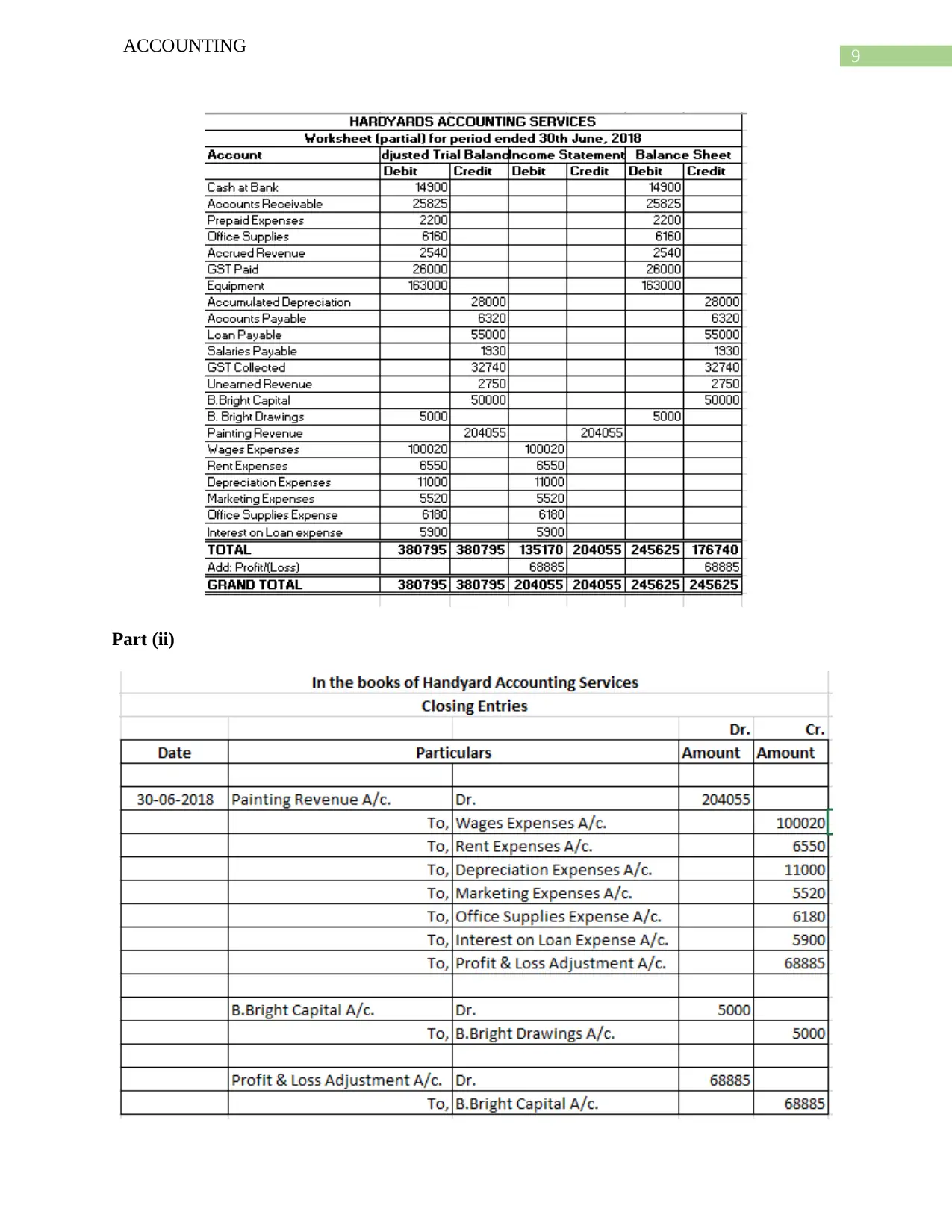
9
ACCOUNTING
Part (ii)
ACCOUNTING
Part (ii)
Secure Best Marks with AI Grader
Need help grading? Try our AI Grader for instant feedback on your assignments.

10
ACCOUNTING
Question 4
Requirement A
a. The use of credit cards will definitely reduce the risks which are associated with normal
credit facilities. The loan amount can directly be dealt with the credit card company. the
process of credit which was previously available will change due to the new credit card
facilities. The credit card facilities will be making the e-commerce facility much easier.
The cost which are to be incurred in case of credit card is related to interest which is
charged at the end of the month. The credit cards are normally protected with a pin code
which is different for different individuals.
b. Account Receivables forms a major part of the financial statements of the company as it
is related to credit sales of the business. The recording and monitoring of account
receivable will not be affected by the introduction of credit cards in the business (Hope,
Thomas and Vyas 2013). This because credit card can be used up to a certain limit which
is not that much in most of the cases, however account receivables transaction may be of
lumpsum amount due to a big order. Therefore, it is necessary for the business to keep
track of the account receivables as effective management of such items results in
increased generation of sales.
Factoring may be defined as a source of financing wherein the account receivables of the
business are sold to financial intermediary who are known as factors at a discount. In simple
words, it is a source of procuring funds by selling off the receivables of the business. It is to be
clearly understood that factoring is not same as a loan and the funds which are received are not to
be considered as debt capital of the business (Michalski 2014).
ACCOUNTING
Question 4
Requirement A
a. The use of credit cards will definitely reduce the risks which are associated with normal
credit facilities. The loan amount can directly be dealt with the credit card company. the
process of credit which was previously available will change due to the new credit card
facilities. The credit card facilities will be making the e-commerce facility much easier.
The cost which are to be incurred in case of credit card is related to interest which is
charged at the end of the month. The credit cards are normally protected with a pin code
which is different for different individuals.
b. Account Receivables forms a major part of the financial statements of the company as it
is related to credit sales of the business. The recording and monitoring of account
receivable will not be affected by the introduction of credit cards in the business (Hope,
Thomas and Vyas 2013). This because credit card can be used up to a certain limit which
is not that much in most of the cases, however account receivables transaction may be of
lumpsum amount due to a big order. Therefore, it is necessary for the business to keep
track of the account receivables as effective management of such items results in
increased generation of sales.
Factoring may be defined as a source of financing wherein the account receivables of the
business are sold to financial intermediary who are known as factors at a discount. In simple
words, it is a source of procuring funds by selling off the receivables of the business. It is to be
clearly understood that factoring is not same as a loan and the funds which are received are not to
be considered as debt capital of the business (Michalski 2014).
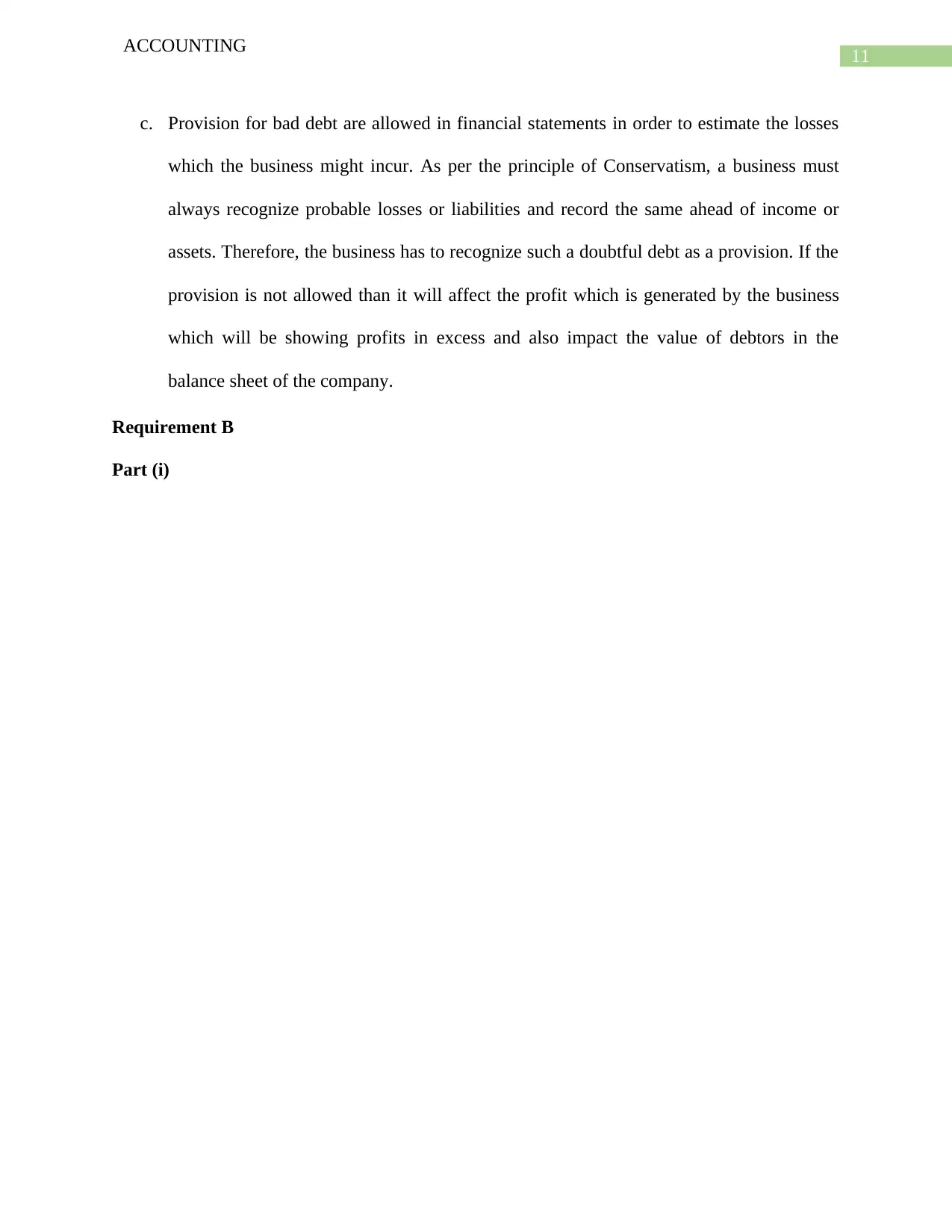
11
ACCOUNTING
c. Provision for bad debt are allowed in financial statements in order to estimate the losses
which the business might incur. As per the principle of Conservatism, a business must
always recognize probable losses or liabilities and record the same ahead of income or
assets. Therefore, the business has to recognize such a doubtful debt as a provision. If the
provision is not allowed than it will affect the profit which is generated by the business
which will be showing profits in excess and also impact the value of debtors in the
balance sheet of the company.
Requirement B
Part (i)
ACCOUNTING
c. Provision for bad debt are allowed in financial statements in order to estimate the losses
which the business might incur. As per the principle of Conservatism, a business must
always recognize probable losses or liabilities and record the same ahead of income or
assets. Therefore, the business has to recognize such a doubtful debt as a provision. If the
provision is not allowed than it will affect the profit which is generated by the business
which will be showing profits in excess and also impact the value of debtors in the
balance sheet of the company.
Requirement B
Part (i)

12
ACCOUNTING
Dr. Cr.
Date Amount Amount
Jun-18 Bad Debts Expenses A/c. Dr. 11510
To, Allowance for Doubtful Debts A/c. 11510
Allowance for Doubtful Debts A/c. Dr. 11510
To, Accounts Receivable A/c. 11510
Cash at Bank A/c. Dr. 19910
Accounts Receivable A/c. Dr. 79640
To, Sales A/c. 90500
To, GST Collected A/c. 9050
Cash at Bank A/c. Dr. 121600
To, Accounts Receivable A/c. 121600
Accounts Receivable A/c. Dr. 1870
To, Allowance for Doubtful Debts A/c. 1870
Cash at Bank A/c. Dr. 1870
To, Accounts Receivable A/c. 1870
Accounts Receivable A/c. Dr. 2200
To, Sales A/c. 2000
To, GST Collected A/c. 200
Profit & Loss A/c. Dr. 1565
To, Allowance for Doubtful Debts A/c. 1565
Journal Entries
(Being the balance of allowance for doubtful debts increased)
Particulars
(Being Bad debt expenses recorded)
(Being accounts receivable written off as bad debt)
(Being sales made in cash and credit both)
(Being dues received from customers)
(Being receivables, writted off previously, reinstated)
(Being dues received from reinstated receivables)
(Being unrecorded credit sales recorded properly)
In the books of Homewares Company Ltd.
Part (ii)
ACCOUNTING
Dr. Cr.
Date Amount Amount
Jun-18 Bad Debts Expenses A/c. Dr. 11510
To, Allowance for Doubtful Debts A/c. 11510
Allowance for Doubtful Debts A/c. Dr. 11510
To, Accounts Receivable A/c. 11510
Cash at Bank A/c. Dr. 19910
Accounts Receivable A/c. Dr. 79640
To, Sales A/c. 90500
To, GST Collected A/c. 9050
Cash at Bank A/c. Dr. 121600
To, Accounts Receivable A/c. 121600
Accounts Receivable A/c. Dr. 1870
To, Allowance for Doubtful Debts A/c. 1870
Cash at Bank A/c. Dr. 1870
To, Accounts Receivable A/c. 1870
Accounts Receivable A/c. Dr. 2200
To, Sales A/c. 2000
To, GST Collected A/c. 200
Profit & Loss A/c. Dr. 1565
To, Allowance for Doubtful Debts A/c. 1565
Journal Entries
(Being the balance of allowance for doubtful debts increased)
Particulars
(Being Bad debt expenses recorded)
(Being accounts receivable written off as bad debt)
(Being sales made in cash and credit both)
(Being dues received from customers)
(Being receivables, writted off previously, reinstated)
(Being dues received from reinstated receivables)
(Being unrecorded credit sales recorded properly)
In the books of Homewares Company Ltd.
Part (ii)
Paraphrase This Document
Need a fresh take? Get an instant paraphrase of this document with our AI Paraphraser
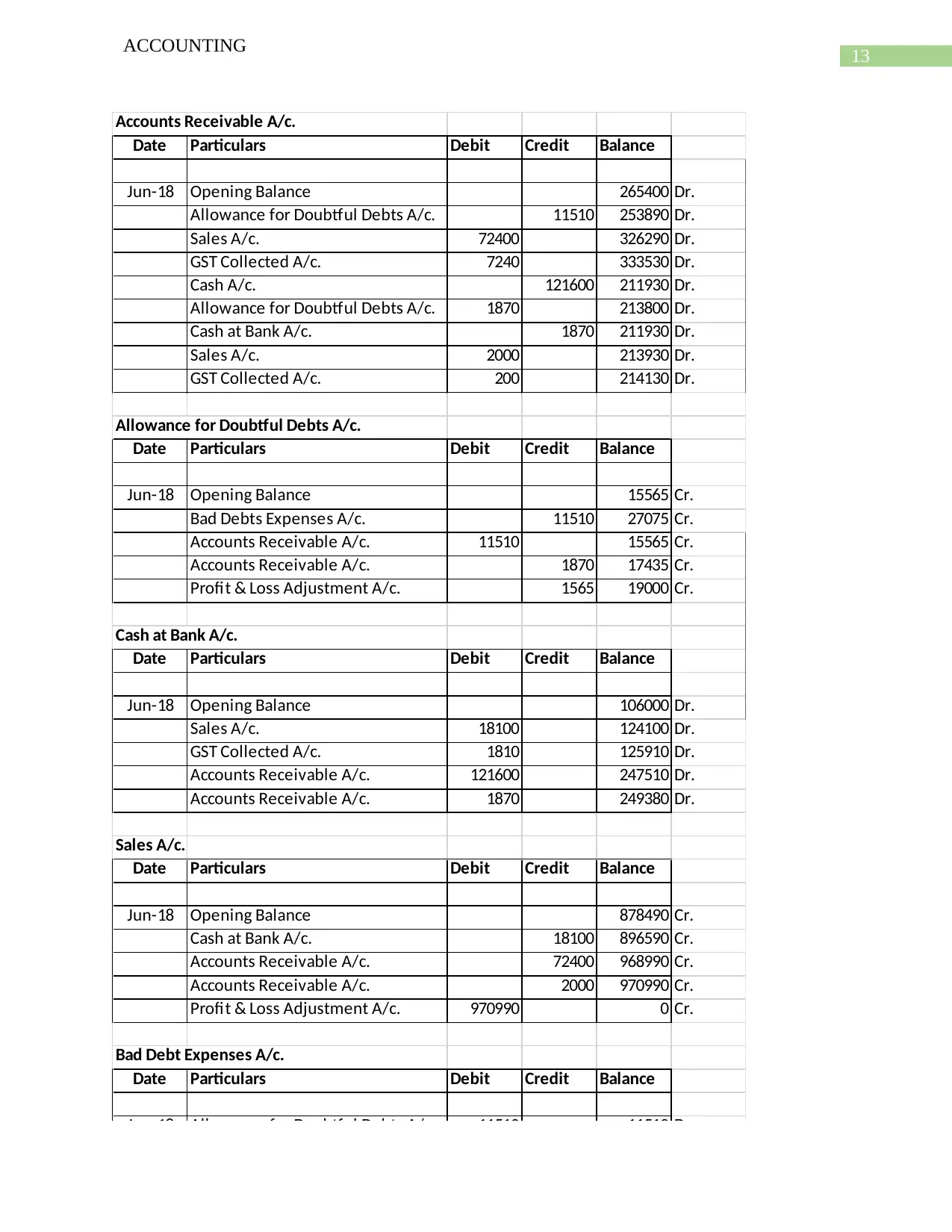
13
ACCOUNTING
Accounts Receivable A/c.
Date Particulars Debit Credit Balance
Jun-18 Opening Balance 265400 Dr.
Allowance for Doubtful Debts A/c. 11510 253890 Dr.
Sales A/c. 72400 326290 Dr.
GST Collected A/c. 7240 333530 Dr.
Cash A/c. 121600 211930 Dr.
Allowance for Doubtful Debts A/c. 1870 213800 Dr.
Cash at Bank A/c. 1870 211930 Dr.
Sales A/c. 2000 213930 Dr.
GST Collected A/c. 200 214130 Dr.
Allowance for Doubtful Debts A/c.
Date Particulars Debit Credit Balance
Jun-18 Opening Balance 15565 Cr.
Bad Debts Expenses A/c. 11510 27075 Cr.
Accounts Receivable A/c. 11510 15565 Cr.
Accounts Receivable A/c. 1870 17435 Cr.
Profit & Loss Adjustment A/c. 1565 19000 Cr.
Cash at Bank A/c.
Date Particulars Debit Credit Balance
Jun-18 Opening Balance 106000 Dr.
Sales A/c. 18100 124100 Dr.
GST Collected A/c. 1810 125910 Dr.
Accounts Receivable A/c. 121600 247510 Dr.
Accounts Receivable A/c. 1870 249380 Dr.
Sales A/c.
Date Particulars Debit Credit Balance
Jun-18 Opening Balance 878490 Cr.
Cash at Bank A/c. 18100 896590 Cr.
Accounts Receivable A/c. 72400 968990 Cr.
Accounts Receivable A/c. 2000 970990 Cr.
Profit & Loss Adjustment A/c. 970990 0 Cr.
Bad Debt Expenses A/c.
Date Particulars Debit Credit Balance
Jun-18 Allowance for Doubtful Debts A/c. 11510 11510 Dr.
Profit & Loss Adjustment A/c. 11510 0
ACCOUNTING
Accounts Receivable A/c.
Date Particulars Debit Credit Balance
Jun-18 Opening Balance 265400 Dr.
Allowance for Doubtful Debts A/c. 11510 253890 Dr.
Sales A/c. 72400 326290 Dr.
GST Collected A/c. 7240 333530 Dr.
Cash A/c. 121600 211930 Dr.
Allowance for Doubtful Debts A/c. 1870 213800 Dr.
Cash at Bank A/c. 1870 211930 Dr.
Sales A/c. 2000 213930 Dr.
GST Collected A/c. 200 214130 Dr.
Allowance for Doubtful Debts A/c.
Date Particulars Debit Credit Balance
Jun-18 Opening Balance 15565 Cr.
Bad Debts Expenses A/c. 11510 27075 Cr.
Accounts Receivable A/c. 11510 15565 Cr.
Accounts Receivable A/c. 1870 17435 Cr.
Profit & Loss Adjustment A/c. 1565 19000 Cr.
Cash at Bank A/c.
Date Particulars Debit Credit Balance
Jun-18 Opening Balance 106000 Dr.
Sales A/c. 18100 124100 Dr.
GST Collected A/c. 1810 125910 Dr.
Accounts Receivable A/c. 121600 247510 Dr.
Accounts Receivable A/c. 1870 249380 Dr.
Sales A/c.
Date Particulars Debit Credit Balance
Jun-18 Opening Balance 878490 Cr.
Cash at Bank A/c. 18100 896590 Cr.
Accounts Receivable A/c. 72400 968990 Cr.
Accounts Receivable A/c. 2000 970990 Cr.
Profit & Loss Adjustment A/c. 970990 0 Cr.
Bad Debt Expenses A/c.
Date Particulars Debit Credit Balance
Jun-18 Allowance for Doubtful Debts A/c. 11510 11510 Dr.
Profit & Loss Adjustment A/c. 11510 0
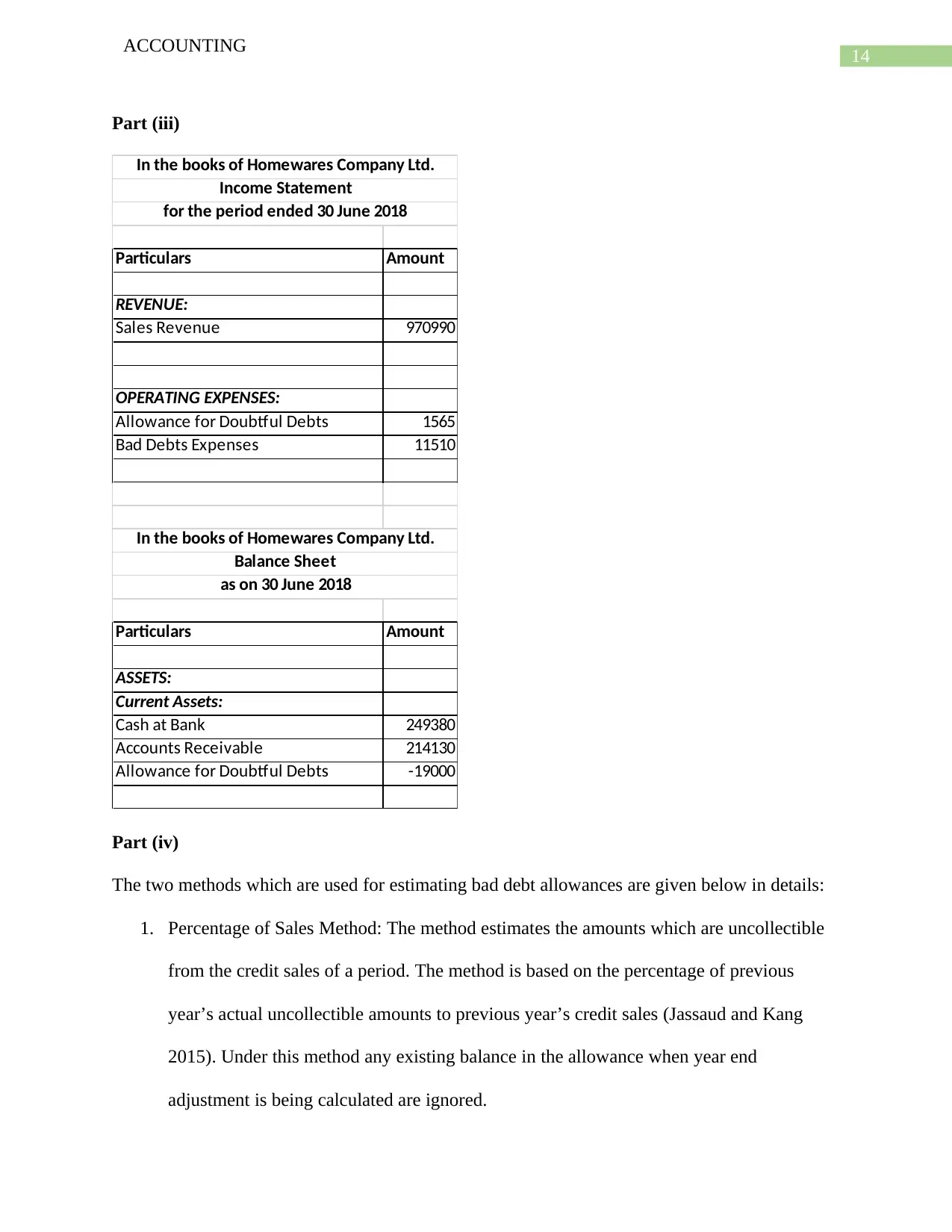
14
ACCOUNTING
Part (iii)
Particulars Amount
REVENUE:
Sales Revenue 970990
OPERATING EXPENSES:
Allowance for Doubtful Debts 1565
Bad Debts Expenses 11510
Particulars Amount
ASSETS:
Current Assets:
Cash at Bank 249380
Accounts Receivable 214130
Allowance for Doubtful Debts -19000
In the books of Homewares Company Ltd.
Income Statement
for the period ended 30 June 2018
In the books of Homewares Company Ltd.
Balance Sheet
as on 30 June 2018
Part (iv)
The two methods which are used for estimating bad debt allowances are given below in details:
1. Percentage of Sales Method: The method estimates the amounts which are uncollectible
from the credit sales of a period. The method is based on the percentage of previous
year’s actual uncollectible amounts to previous year’s credit sales (Jassaud and Kang
2015). Under this method any existing balance in the allowance when year end
adjustment is being calculated are ignored.
ACCOUNTING
Part (iii)
Particulars Amount
REVENUE:
Sales Revenue 970990
OPERATING EXPENSES:
Allowance for Doubtful Debts 1565
Bad Debts Expenses 11510
Particulars Amount
ASSETS:
Current Assets:
Cash at Bank 249380
Accounts Receivable 214130
Allowance for Doubtful Debts -19000
In the books of Homewares Company Ltd.
Income Statement
for the period ended 30 June 2018
In the books of Homewares Company Ltd.
Balance Sheet
as on 30 June 2018
Part (iv)
The two methods which are used for estimating bad debt allowances are given below in details:
1. Percentage of Sales Method: The method estimates the amounts which are uncollectible
from the credit sales of a period. The method is based on the percentage of previous
year’s actual uncollectible amounts to previous year’s credit sales (Jassaud and Kang
2015). Under this method any existing balance in the allowance when year end
adjustment is being calculated are ignored.
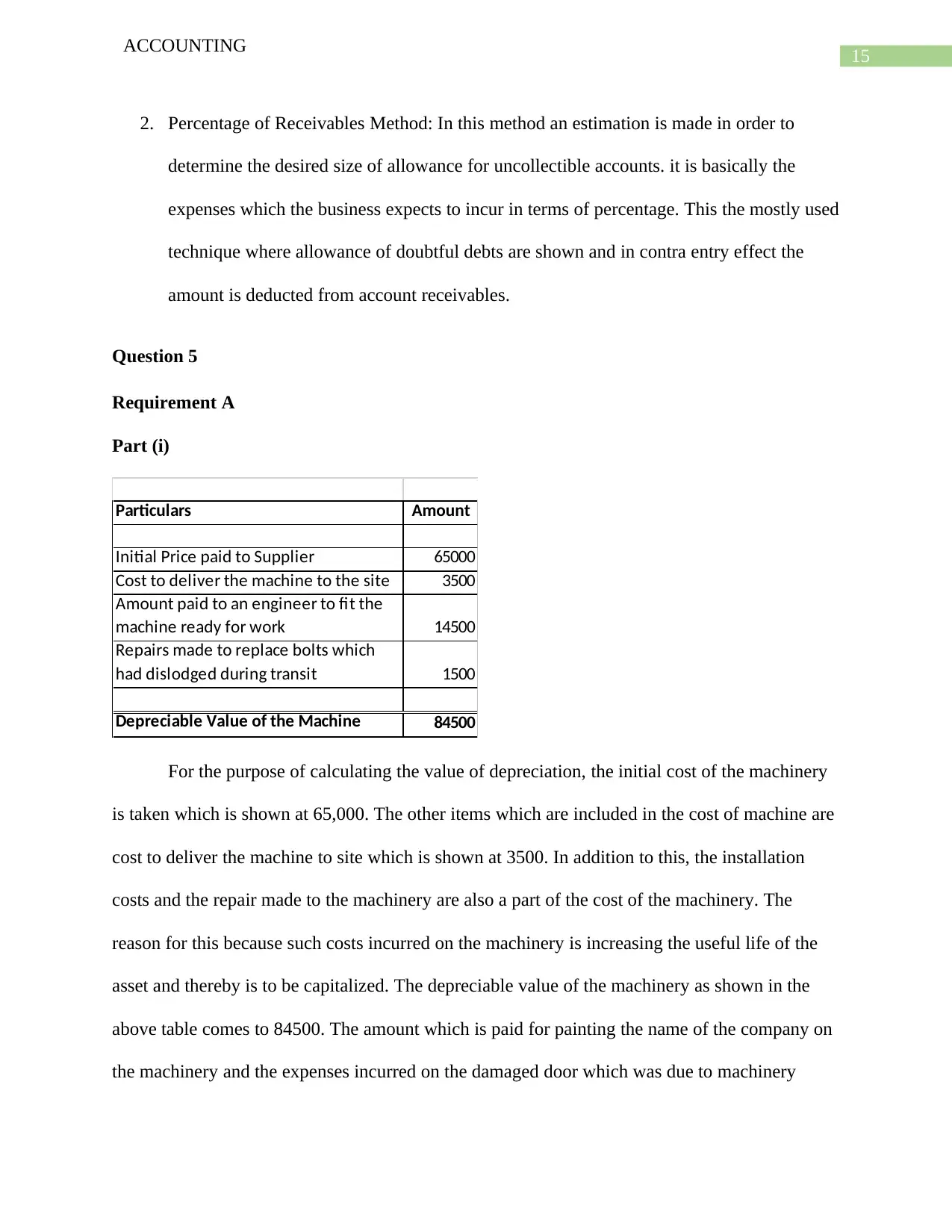
15
ACCOUNTING
2. Percentage of Receivables Method: In this method an estimation is made in order to
determine the desired size of allowance for uncollectible accounts. it is basically the
expenses which the business expects to incur in terms of percentage. This the mostly used
technique where allowance of doubtful debts are shown and in contra entry effect the
amount is deducted from account receivables.
Question 5
Requirement A
Part (i)
Particulars Amount
Initial Price paid to Supplier 65000
Cost to deliver the machine to the site 3500
Amount paid to an engineer to fit the
machine ready for work 14500
Repairs made to replace bolts which
had dislodged during transit 1500
Depreciable Value of the Machine 84500
For the purpose of calculating the value of depreciation, the initial cost of the machinery
is taken which is shown at 65,000. The other items which are included in the cost of machine are
cost to deliver the machine to site which is shown at 3500. In addition to this, the installation
costs and the repair made to the machinery are also a part of the cost of the machinery. The
reason for this because such costs incurred on the machinery is increasing the useful life of the
asset and thereby is to be capitalized. The depreciable value of the machinery as shown in the
above table comes to 84500. The amount which is paid for painting the name of the company on
the machinery and the expenses incurred on the damaged door which was due to machinery
ACCOUNTING
2. Percentage of Receivables Method: In this method an estimation is made in order to
determine the desired size of allowance for uncollectible accounts. it is basically the
expenses which the business expects to incur in terms of percentage. This the mostly used
technique where allowance of doubtful debts are shown and in contra entry effect the
amount is deducted from account receivables.
Question 5
Requirement A
Part (i)
Particulars Amount
Initial Price paid to Supplier 65000
Cost to deliver the machine to the site 3500
Amount paid to an engineer to fit the
machine ready for work 14500
Repairs made to replace bolts which
had dislodged during transit 1500
Depreciable Value of the Machine 84500
For the purpose of calculating the value of depreciation, the initial cost of the machinery
is taken which is shown at 65,000. The other items which are included in the cost of machine are
cost to deliver the machine to site which is shown at 3500. In addition to this, the installation
costs and the repair made to the machinery are also a part of the cost of the machinery. The
reason for this because such costs incurred on the machinery is increasing the useful life of the
asset and thereby is to be capitalized. The depreciable value of the machinery as shown in the
above table comes to 84500. The amount which is paid for painting the name of the company on
the machinery and the expenses incurred on the damaged door which was due to machinery
Secure Best Marks with AI Grader
Need help grading? Try our AI Grader for instant feedback on your assignments.
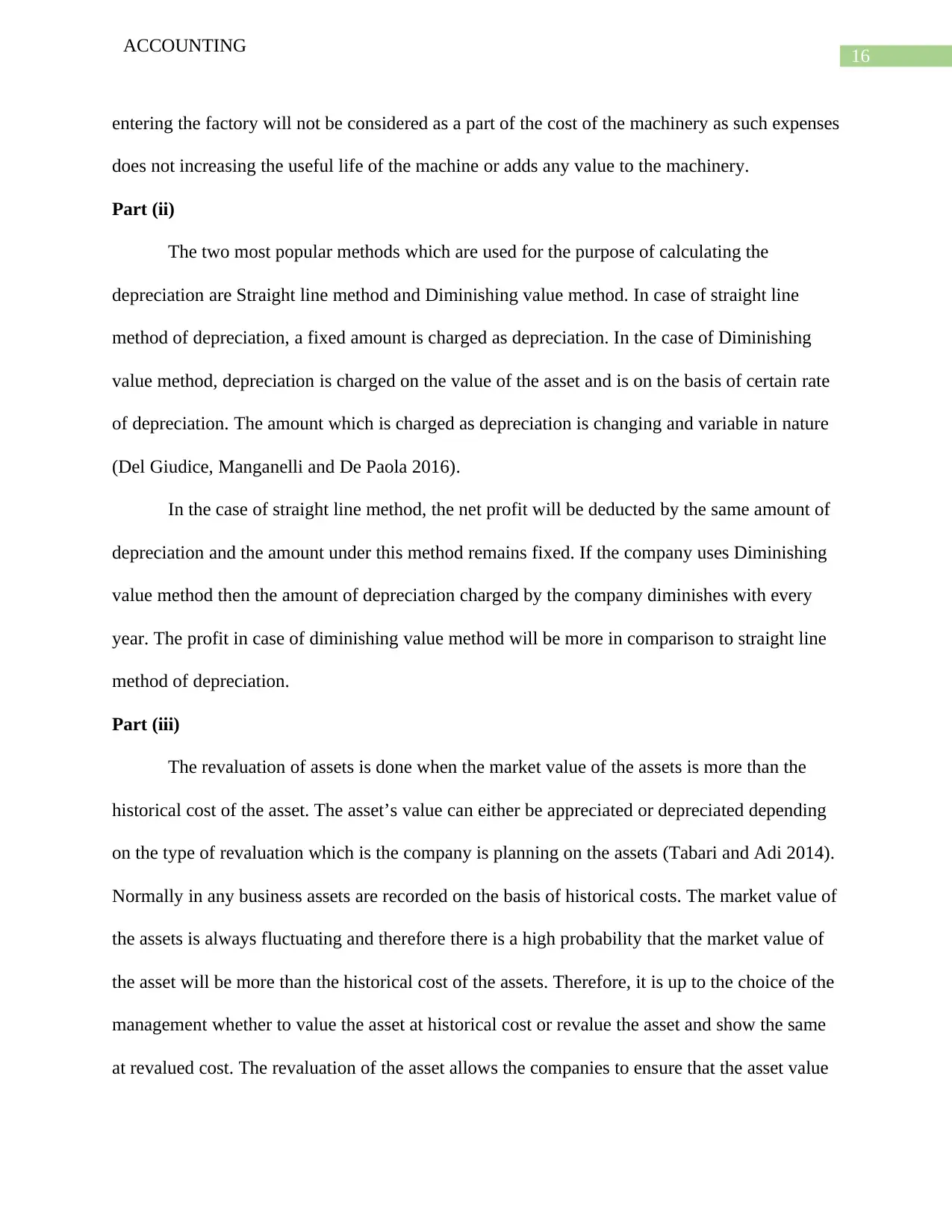
16
ACCOUNTING
entering the factory will not be considered as a part of the cost of the machinery as such expenses
does not increasing the useful life of the machine or adds any value to the machinery.
Part (ii)
The two most popular methods which are used for the purpose of calculating the
depreciation are Straight line method and Diminishing value method. In case of straight line
method of depreciation, a fixed amount is charged as depreciation. In the case of Diminishing
value method, depreciation is charged on the value of the asset and is on the basis of certain rate
of depreciation. The amount which is charged as depreciation is changing and variable in nature
(Del Giudice, Manganelli and De Paola 2016).
In the case of straight line method, the net profit will be deducted by the same amount of
depreciation and the amount under this method remains fixed. If the company uses Diminishing
value method then the amount of depreciation charged by the company diminishes with every
year. The profit in case of diminishing value method will be more in comparison to straight line
method of depreciation.
Part (iii)
The revaluation of assets is done when the market value of the assets is more than the
historical cost of the asset. The asset’s value can either be appreciated or depreciated depending
on the type of revaluation which is the company is planning on the assets (Tabari and Adi 2014).
Normally in any business assets are recorded on the basis of historical costs. The market value of
the assets is always fluctuating and therefore there is a high probability that the market value of
the asset will be more than the historical cost of the assets. Therefore, it is up to the choice of the
management whether to value the asset at historical cost or revalue the asset and show the same
at revalued cost. The revaluation of the asset allows the companies to ensure that the asset value
ACCOUNTING
entering the factory will not be considered as a part of the cost of the machinery as such expenses
does not increasing the useful life of the machine or adds any value to the machinery.
Part (ii)
The two most popular methods which are used for the purpose of calculating the
depreciation are Straight line method and Diminishing value method. In case of straight line
method of depreciation, a fixed amount is charged as depreciation. In the case of Diminishing
value method, depreciation is charged on the value of the asset and is on the basis of certain rate
of depreciation. The amount which is charged as depreciation is changing and variable in nature
(Del Giudice, Manganelli and De Paola 2016).
In the case of straight line method, the net profit will be deducted by the same amount of
depreciation and the amount under this method remains fixed. If the company uses Diminishing
value method then the amount of depreciation charged by the company diminishes with every
year. The profit in case of diminishing value method will be more in comparison to straight line
method of depreciation.
Part (iii)
The revaluation of assets is done when the market value of the assets is more than the
historical cost of the asset. The asset’s value can either be appreciated or depreciated depending
on the type of revaluation which is the company is planning on the assets (Tabari and Adi 2014).
Normally in any business assets are recorded on the basis of historical costs. The market value of
the assets is always fluctuating and therefore there is a high probability that the market value of
the asset will be more than the historical cost of the assets. Therefore, it is up to the choice of the
management whether to value the asset at historical cost or revalue the asset and show the same
at revalued cost. The revaluation of the asset allows the companies to ensure that the asset value
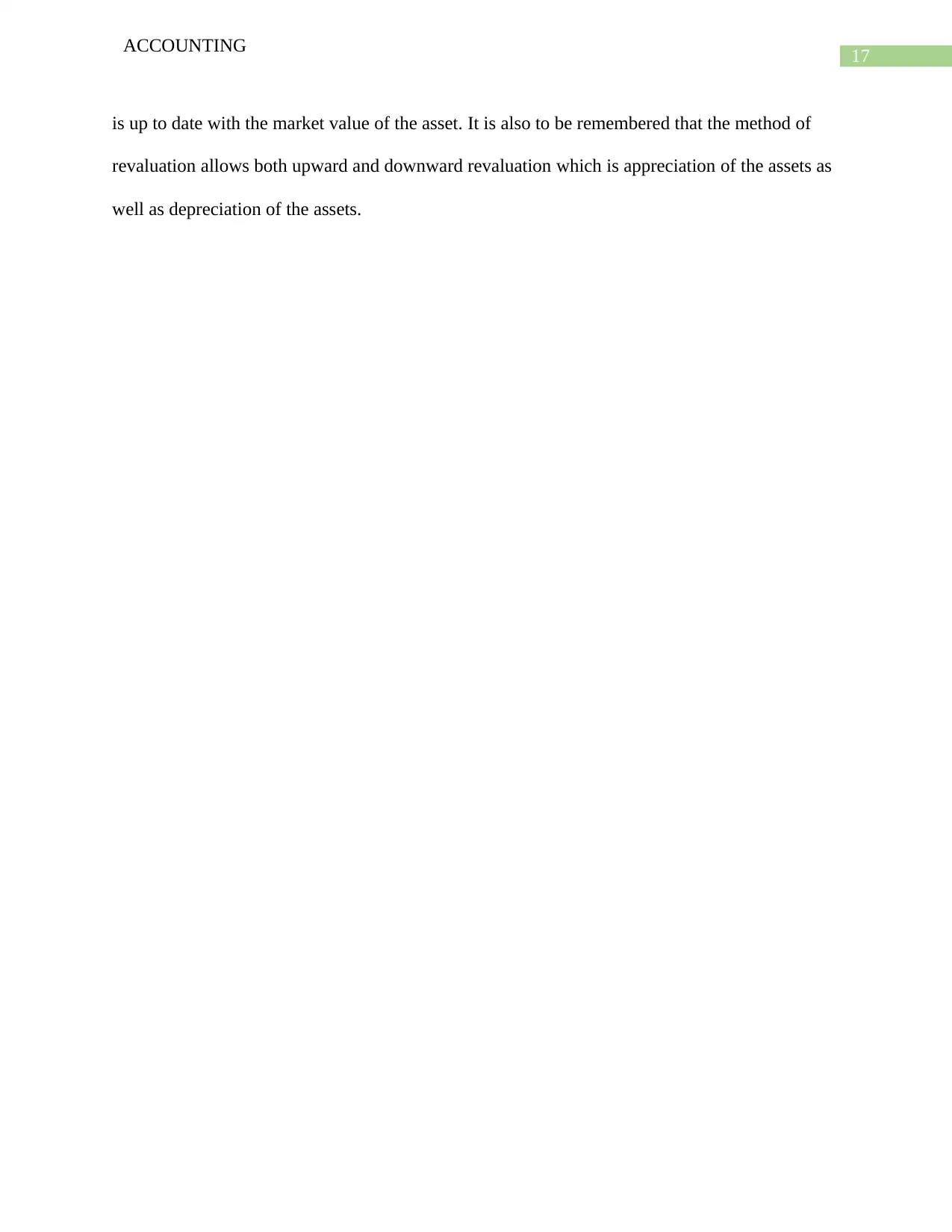
17
ACCOUNTING
is up to date with the market value of the asset. It is also to be remembered that the method of
revaluation allows both upward and downward revaluation which is appreciation of the assets as
well as depreciation of the assets.
ACCOUNTING
is up to date with the market value of the asset. It is also to be remembered that the method of
revaluation allows both upward and downward revaluation which is appreciation of the assets as
well as depreciation of the assets.
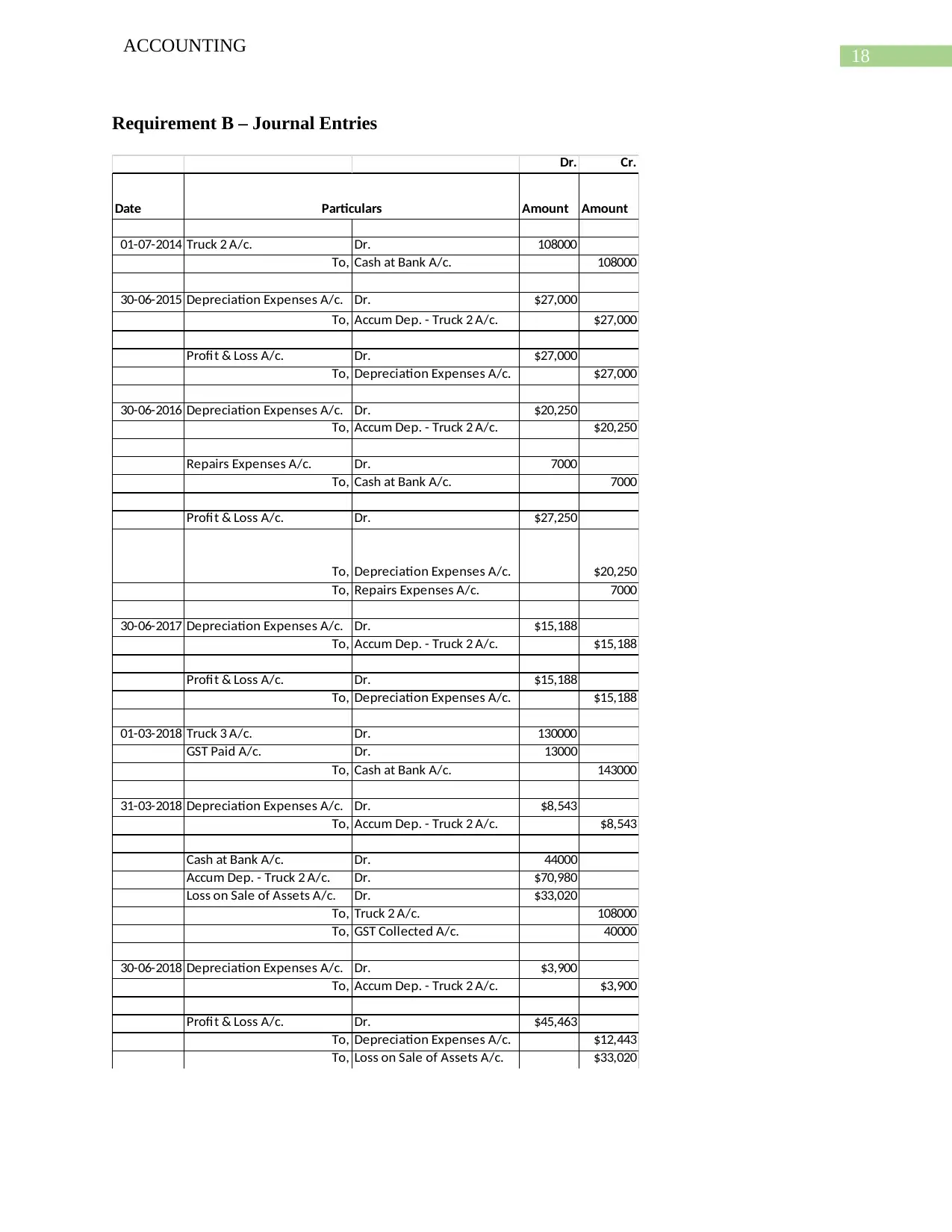
18
ACCOUNTING
Requirement B – Journal Entries
Dr. Cr.
Date Amount Amount
01-07-2014 Truck 2 A/c. Dr. 108000
To, Cash at Bank A/c. 108000
30-06-2015 Depreciation Expenses A/c. Dr. $27,000
To, Accum Dep. - Truck 2 A/c. $27,000
Profit & Loss A/c. Dr. $27,000
To, Depreciation Expenses A/c. $27,000
30-06-2016 Depreciation Expenses A/c. Dr. $20,250
To, Accum Dep. - Truck 2 A/c. $20,250
Repairs Expenses A/c. Dr. 7000
To, Cash at Bank A/c. 7000
Profit & Loss A/c. Dr. $27,250
To, Depreciation Expenses A/c. $20,250
To, Repairs Expenses A/c. 7000
30-06-2017 Depreciation Expenses A/c. Dr. $15,188
To, Accum Dep. - Truck 2 A/c. $15,188
Profit & Loss A/c. Dr. $15,188
To, Depreciation Expenses A/c. $15,188
01-03-2018 Truck 3 A/c. Dr. 130000
GST Paid A/c. Dr. 13000
To, Cash at Bank A/c. 143000
31-03-2018 Depreciation Expenses A/c. Dr. $8,543
To, Accum Dep. - Truck 2 A/c. $8,543
Cash at Bank A/c. Dr. 44000
Accum Dep. - Truck 2 A/c. Dr. $70,980
Loss on Sale of Assets A/c. Dr. $33,020
To, Truck 2 A/c. 108000
To, GST Collected A/c. 40000
30-06-2018 Depreciation Expenses A/c. Dr. $3,900
To, Accum Dep. - Truck 2 A/c. $3,900
Profit & Loss A/c. Dr. $45,463
To, Depreciation Expenses A/c. $12,443
To, Loss on Sale of Assets A/c. $33,020
Particulars
ACCOUNTING
Requirement B – Journal Entries
Dr. Cr.
Date Amount Amount
01-07-2014 Truck 2 A/c. Dr. 108000
To, Cash at Bank A/c. 108000
30-06-2015 Depreciation Expenses A/c. Dr. $27,000
To, Accum Dep. - Truck 2 A/c. $27,000
Profit & Loss A/c. Dr. $27,000
To, Depreciation Expenses A/c. $27,000
30-06-2016 Depreciation Expenses A/c. Dr. $20,250
To, Accum Dep. - Truck 2 A/c. $20,250
Repairs Expenses A/c. Dr. 7000
To, Cash at Bank A/c. 7000
Profit & Loss A/c. Dr. $27,250
To, Depreciation Expenses A/c. $20,250
To, Repairs Expenses A/c. 7000
30-06-2017 Depreciation Expenses A/c. Dr. $15,188
To, Accum Dep. - Truck 2 A/c. $15,188
Profit & Loss A/c. Dr. $15,188
To, Depreciation Expenses A/c. $15,188
01-03-2018 Truck 3 A/c. Dr. 130000
GST Paid A/c. Dr. 13000
To, Cash at Bank A/c. 143000
31-03-2018 Depreciation Expenses A/c. Dr. $8,543
To, Accum Dep. - Truck 2 A/c. $8,543
Cash at Bank A/c. Dr. 44000
Accum Dep. - Truck 2 A/c. Dr. $70,980
Loss on Sale of Assets A/c. Dr. $33,020
To, Truck 2 A/c. 108000
To, GST Collected A/c. 40000
30-06-2018 Depreciation Expenses A/c. Dr. $3,900
To, Accum Dep. - Truck 2 A/c. $3,900
Profit & Loss A/c. Dr. $45,463
To, Depreciation Expenses A/c. $12,443
To, Loss on Sale of Assets A/c. $33,020
Particulars
Paraphrase This Document
Need a fresh take? Get an instant paraphrase of this document with our AI Paraphraser
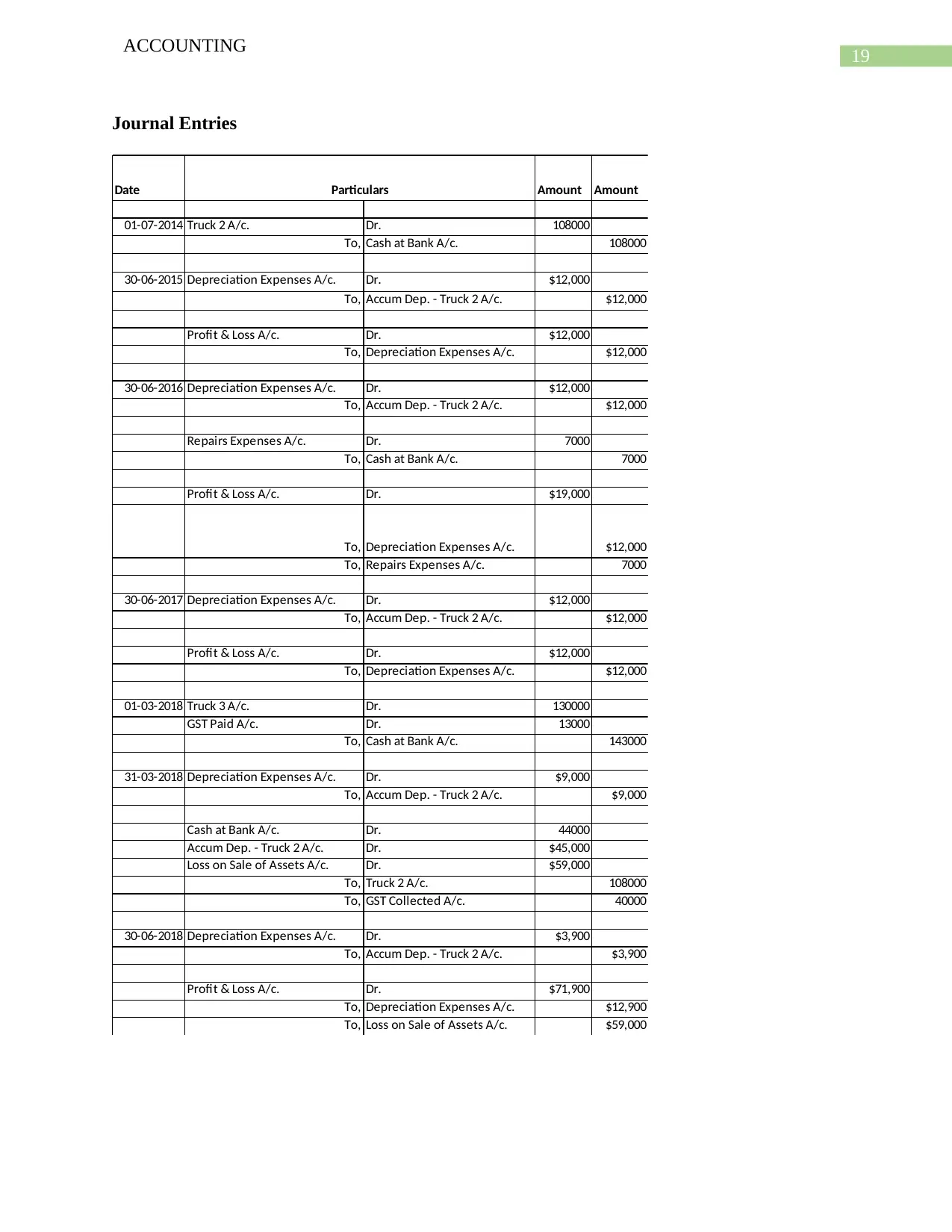
19
ACCOUNTING
Journal Entries
Date Amount Amount
01-07-2014 Truck 2 A/c. Dr. 108000
To, Cash at Bank A/c. 108000
30-06-2015 Depreciation Expenses A/c. Dr. $12,000
To, Accum Dep. - Truck 2 A/c. $12,000
Profit & Loss A/c. Dr. $12,000
To, Depreciation Expenses A/c. $12,000
30-06-2016 Depreciation Expenses A/c. Dr. $12,000
To, Accum Dep. - Truck 2 A/c. $12,000
Repairs Expenses A/c. Dr. 7000
To, Cash at Bank A/c. 7000
Profit & Loss A/c. Dr. $19,000
To, Depreciation Expenses A/c. $12,000
To, Repairs Expenses A/c. 7000
30-06-2017 Depreciation Expenses A/c. Dr. $12,000
To, Accum Dep. - Truck 2 A/c. $12,000
Profit & Loss A/c. Dr. $12,000
To, Depreciation Expenses A/c. $12,000
01-03-2018 Truck 3 A/c. Dr. 130000
GST Paid A/c. Dr. 13000
To, Cash at Bank A/c. 143000
31-03-2018 Depreciation Expenses A/c. Dr. $9,000
To, Accum Dep. - Truck 2 A/c. $9,000
Cash at Bank A/c. Dr. 44000
Accum Dep. - Truck 2 A/c. Dr. $45,000
Loss on Sale of Assets A/c. Dr. $59,000
To, Truck 2 A/c. 108000
To, GST Collected A/c. 40000
30-06-2018 Depreciation Expenses A/c. Dr. $3,900
To, Accum Dep. - Truck 2 A/c. $3,900
Profit & Loss A/c. Dr. $71,900
To, Depreciation Expenses A/c. $12,900
To, Loss on Sale of Assets A/c. $59,000
Particulars
ACCOUNTING
Journal Entries
Date Amount Amount
01-07-2014 Truck 2 A/c. Dr. 108000
To, Cash at Bank A/c. 108000
30-06-2015 Depreciation Expenses A/c. Dr. $12,000
To, Accum Dep. - Truck 2 A/c. $12,000
Profit & Loss A/c. Dr. $12,000
To, Depreciation Expenses A/c. $12,000
30-06-2016 Depreciation Expenses A/c. Dr. $12,000
To, Accum Dep. - Truck 2 A/c. $12,000
Repairs Expenses A/c. Dr. 7000
To, Cash at Bank A/c. 7000
Profit & Loss A/c. Dr. $19,000
To, Depreciation Expenses A/c. $12,000
To, Repairs Expenses A/c. 7000
30-06-2017 Depreciation Expenses A/c. Dr. $12,000
To, Accum Dep. - Truck 2 A/c. $12,000
Profit & Loss A/c. Dr. $12,000
To, Depreciation Expenses A/c. $12,000
01-03-2018 Truck 3 A/c. Dr. 130000
GST Paid A/c. Dr. 13000
To, Cash at Bank A/c. 143000
31-03-2018 Depreciation Expenses A/c. Dr. $9,000
To, Accum Dep. - Truck 2 A/c. $9,000
Cash at Bank A/c. Dr. 44000
Accum Dep. - Truck 2 A/c. Dr. $45,000
Loss on Sale of Assets A/c. Dr. $59,000
To, Truck 2 A/c. 108000
To, GST Collected A/c. 40000
30-06-2018 Depreciation Expenses A/c. Dr. $3,900
To, Accum Dep. - Truck 2 A/c. $3,900
Profit & Loss A/c. Dr. $71,900
To, Depreciation Expenses A/c. $12,900
To, Loss on Sale of Assets A/c. $59,000
Particulars
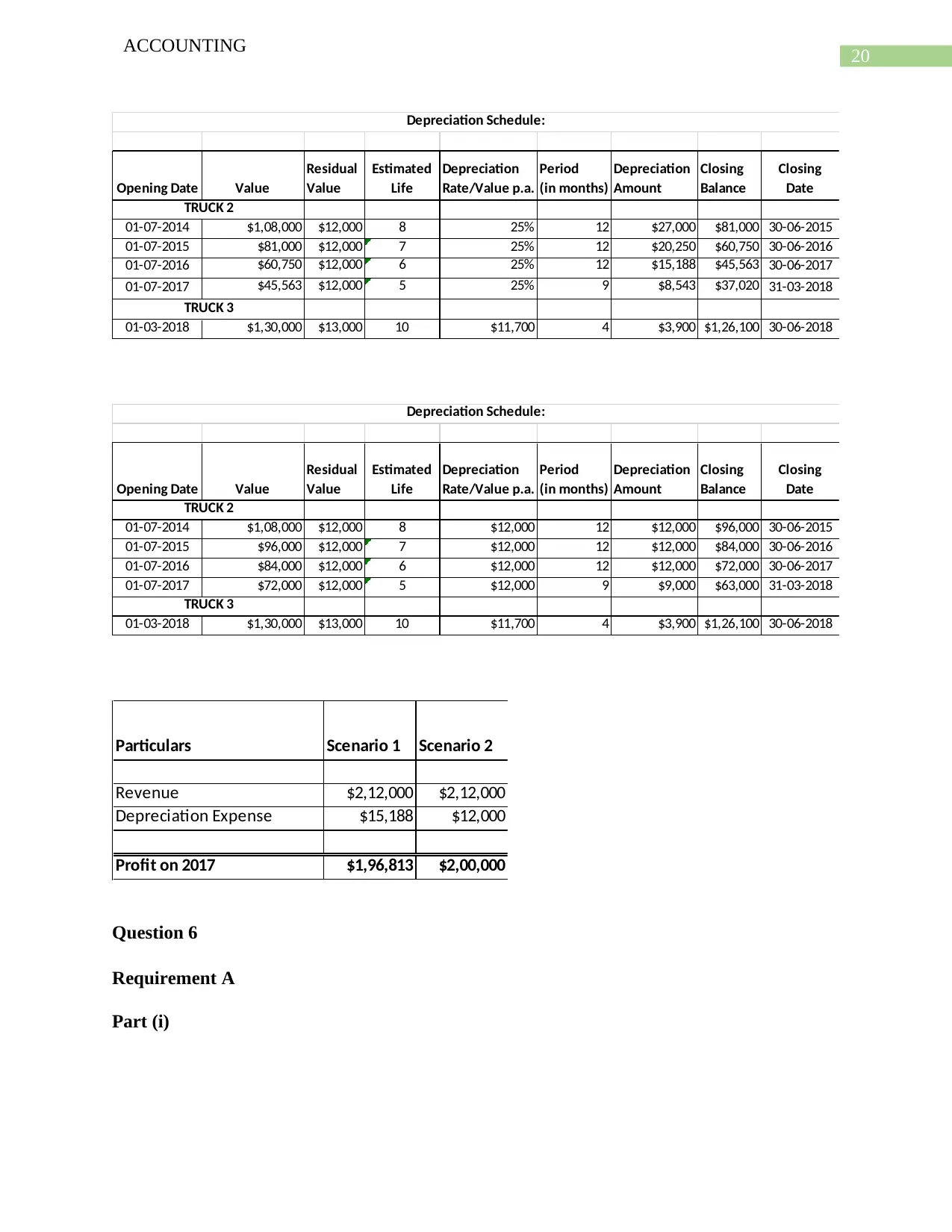
20
ACCOUNTING
Opening Date Value
Residual
Value
Estimated
Life
Depreciation
Rate/Value p.a.
Period
(in months)
Depreciation
Amount
Closing
Balance
Closing
Date
01-07-2014 $1,08,000 $12,000 8 25% 12 $27,000 $81,000 30-06-2015
01-07-2015 $81,000 $12,000 7 25% 12 $20,250 $60,750 30-06-2016
01-07-2016 $60,750 $12,000 6 25% 12 $15,188 $45,563 30-06-2017
01-07-2017 $45,563 $12,000 5 25% 9 $8,543 $37,020 31-03-2018
01-03-2018 $1,30,000 $13,000 10 $11,700 4 $3,900 $1,26,100 30-06-2018
Depreciation Schedule:
TRUCK 2
TRUCK 3
Opening Date Value
Residual
Value
Estimated
Life
Depreciation
Rate/Value p.a.
Period
(in months)
Depreciation
Amount
Closing
Balance
Closing
Date
01-07-2014 $1,08,000 $12,000 8 $12,000 12 $12,000 $96,000 30-06-2015
01-07-2015 $96,000 $12,000 7 $12,000 12 $12,000 $84,000 30-06-2016
01-07-2016 $84,000 $12,000 6 $12,000 12 $12,000 $72,000 30-06-2017
01-07-2017 $72,000 $12,000 5 $12,000 9 $9,000 $63,000 31-03-2018
01-03-2018 $1,30,000 $13,000 10 $11,700 4 $3,900 $1,26,100 30-06-2018
Depreciation Schedule:
TRUCK 2
TRUCK 3
Particulars Scenario 1 Scenario 2
Revenue $2,12,000 $2,12,000
Depreciation Expense $15,188 $12,000
Profit on 2017 $1,96,813 $2,00,000
Question 6
Requirement A
Part (i)
ACCOUNTING
Opening Date Value
Residual
Value
Estimated
Life
Depreciation
Rate/Value p.a.
Period
(in months)
Depreciation
Amount
Closing
Balance
Closing
Date
01-07-2014 $1,08,000 $12,000 8 25% 12 $27,000 $81,000 30-06-2015
01-07-2015 $81,000 $12,000 7 25% 12 $20,250 $60,750 30-06-2016
01-07-2016 $60,750 $12,000 6 25% 12 $15,188 $45,563 30-06-2017
01-07-2017 $45,563 $12,000 5 25% 9 $8,543 $37,020 31-03-2018
01-03-2018 $1,30,000 $13,000 10 $11,700 4 $3,900 $1,26,100 30-06-2018
Depreciation Schedule:
TRUCK 2
TRUCK 3
Opening Date Value
Residual
Value
Estimated
Life
Depreciation
Rate/Value p.a.
Period
(in months)
Depreciation
Amount
Closing
Balance
Closing
Date
01-07-2014 $1,08,000 $12,000 8 $12,000 12 $12,000 $96,000 30-06-2015
01-07-2015 $96,000 $12,000 7 $12,000 12 $12,000 $84,000 30-06-2016
01-07-2016 $84,000 $12,000 6 $12,000 12 $12,000 $72,000 30-06-2017
01-07-2017 $72,000 $12,000 5 $12,000 9 $9,000 $63,000 31-03-2018
01-03-2018 $1,30,000 $13,000 10 $11,700 4 $3,900 $1,26,100 30-06-2018
Depreciation Schedule:
TRUCK 2
TRUCK 3
Particulars Scenario 1 Scenario 2
Revenue $2,12,000 $2,12,000
Depreciation Expense $15,188 $12,000
Profit on 2017 $1,96,813 $2,00,000
Question 6
Requirement A
Part (i)
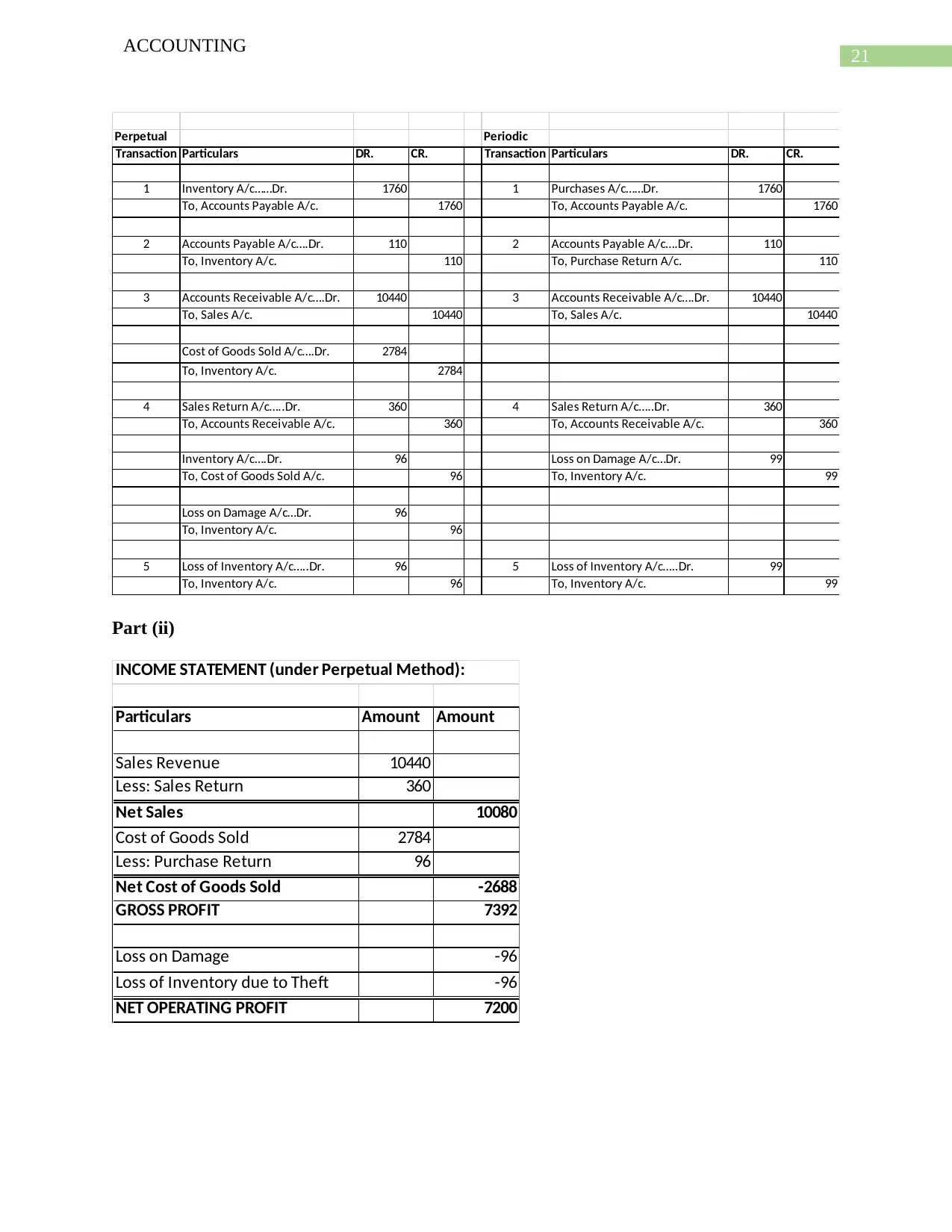
21
ACCOUNTING
Perpetual Periodic
Transaction Particulars DR. CR. Transaction Particulars DR. CR.
1 Inventory A/c……Dr. 1760 1 Purchases A/c……Dr. 1760
To, Accounts Payable A/c. 1760 To, Accounts Payable A/c. 1760
2 Accounts Payable A/c….Dr. 110 2 Accounts Payable A/c….Dr. 110
To, Inventory A/c. 110 To, Purchase Return A/c. 110
3 Accounts Receivable A/c….Dr. 10440 3 Accounts Receivable A/c….Dr. 10440
To, Sales A/c. 10440 To, Sales A/c. 10440
Cost of Goods Sold A/c….Dr. 2784
To, Inventory A/c. 2784
4 Sales Return A/c…..Dr. 360 4 Sales Return A/c…..Dr. 360
To, Accounts Receivable A/c. 360 To, Accounts Receivable A/c. 360
Inventory A/c….Dr. 96 Loss on Damage A/c…Dr. 99
To, Cost of Goods Sold A/c. 96 To, Inventory A/c. 99
Loss on Damage A/c…Dr. 96
To, Inventory A/c. 96
5 Loss of Inventory A/c…..Dr. 96 5 Loss of Inventory A/c…..Dr. 99
To, Inventory A/c. 96 To, Inventory A/c. 99
Part (ii)
INCOME STATEMENT (under Perpetual Method):
Particulars Amount Amount
Sales Revenue 10440
Less: Sales Return 360
Net Sales 10080
Cost of Goods Sold 2784
Less: Purchase Return 96
Net Cost of Goods Sold -2688
GROSS PROFIT 7392
Loss on Damage -96
Loss of Inventory due to Theft -96
NET OPERATING PROFIT 7200
ACCOUNTING
Perpetual Periodic
Transaction Particulars DR. CR. Transaction Particulars DR. CR.
1 Inventory A/c……Dr. 1760 1 Purchases A/c……Dr. 1760
To, Accounts Payable A/c. 1760 To, Accounts Payable A/c. 1760
2 Accounts Payable A/c….Dr. 110 2 Accounts Payable A/c….Dr. 110
To, Inventory A/c. 110 To, Purchase Return A/c. 110
3 Accounts Receivable A/c….Dr. 10440 3 Accounts Receivable A/c….Dr. 10440
To, Sales A/c. 10440 To, Sales A/c. 10440
Cost of Goods Sold A/c….Dr. 2784
To, Inventory A/c. 2784
4 Sales Return A/c…..Dr. 360 4 Sales Return A/c…..Dr. 360
To, Accounts Receivable A/c. 360 To, Accounts Receivable A/c. 360
Inventory A/c….Dr. 96 Loss on Damage A/c…Dr. 99
To, Cost of Goods Sold A/c. 96 To, Inventory A/c. 99
Loss on Damage A/c…Dr. 96
To, Inventory A/c. 96
5 Loss of Inventory A/c…..Dr. 96 5 Loss of Inventory A/c…..Dr. 99
To, Inventory A/c. 96 To, Inventory A/c. 99
Part (ii)
INCOME STATEMENT (under Perpetual Method):
Particulars Amount Amount
Sales Revenue 10440
Less: Sales Return 360
Net Sales 10080
Cost of Goods Sold 2784
Less: Purchase Return 96
Net Cost of Goods Sold -2688
GROSS PROFIT 7392
Loss on Damage -96
Loss of Inventory due to Theft -96
NET OPERATING PROFIT 7200
Secure Best Marks with AI Grader
Need help grading? Try our AI Grader for instant feedback on your assignments.
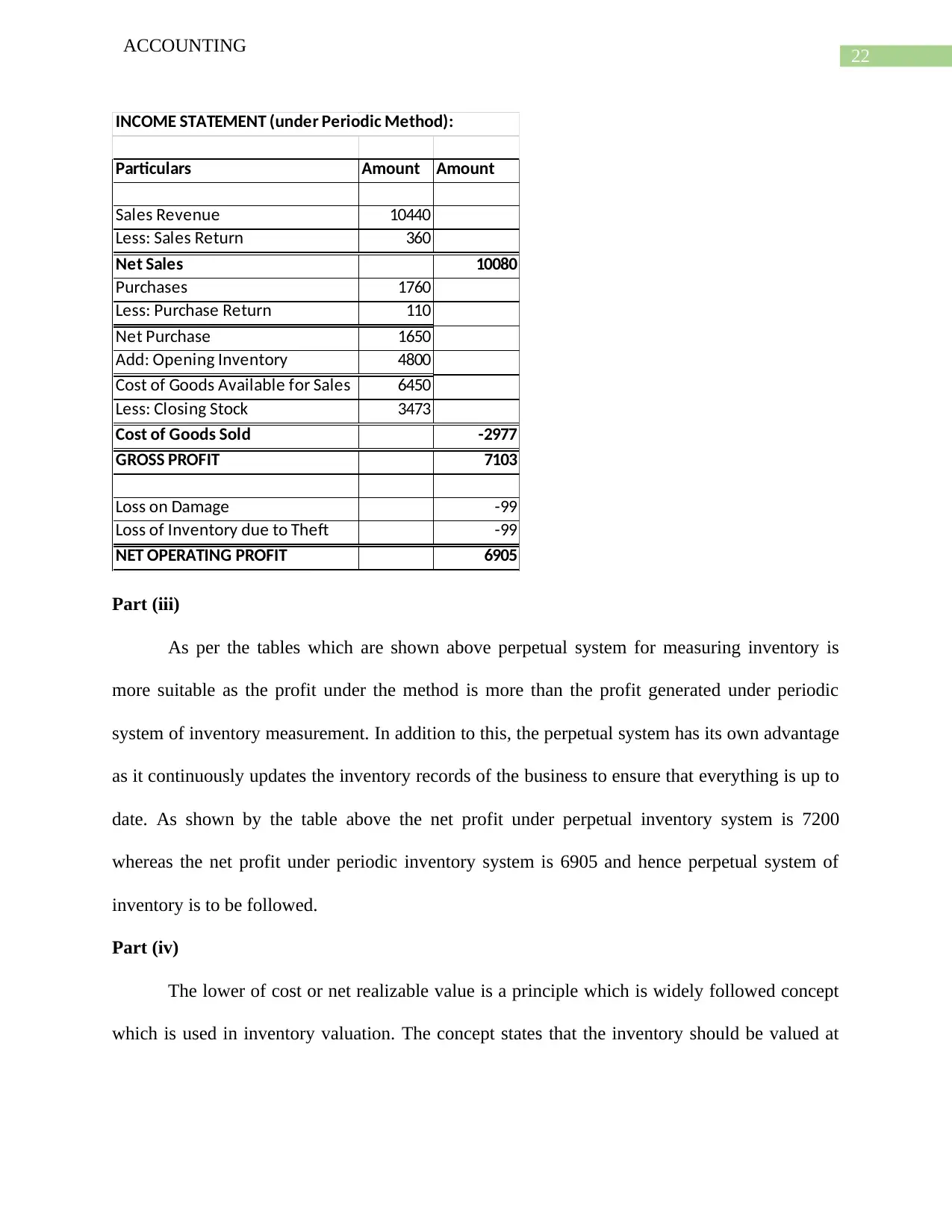
22
ACCOUNTING
INCOME STATEMENT (under Periodic Method):
Particulars Amount Amount
Sales Revenue 10440
Less: Sales Return 360
Net Sales 10080
Purchases 1760
Less: Purchase Return 110
Net Purchase 1650
Add: Opening Inventory 4800
Cost of Goods Available for Sales 6450
Less: Closing Stock 3473
Cost of Goods Sold -2977
GROSS PROFIT 7103
Loss on Damage -99
Loss of Inventory due to Theft -99
NET OPERATING PROFIT 6905
Part (iii)
As per the tables which are shown above perpetual system for measuring inventory is
more suitable as the profit under the method is more than the profit generated under periodic
system of inventory measurement. In addition to this, the perpetual system has its own advantage
as it continuously updates the inventory records of the business to ensure that everything is up to
date. As shown by the table above the net profit under perpetual inventory system is 7200
whereas the net profit under periodic inventory system is 6905 and hence perpetual system of
inventory is to be followed.
Part (iv)
The lower of cost or net realizable value is a principle which is widely followed concept
which is used in inventory valuation. The concept states that the inventory should be valued at
ACCOUNTING
INCOME STATEMENT (under Periodic Method):
Particulars Amount Amount
Sales Revenue 10440
Less: Sales Return 360
Net Sales 10080
Purchases 1760
Less: Purchase Return 110
Net Purchase 1650
Add: Opening Inventory 4800
Cost of Goods Available for Sales 6450
Less: Closing Stock 3473
Cost of Goods Sold -2977
GROSS PROFIT 7103
Loss on Damage -99
Loss of Inventory due to Theft -99
NET OPERATING PROFIT 6905
Part (iii)
As per the tables which are shown above perpetual system for measuring inventory is
more suitable as the profit under the method is more than the profit generated under periodic
system of inventory measurement. In addition to this, the perpetual system has its own advantage
as it continuously updates the inventory records of the business to ensure that everything is up to
date. As shown by the table above the net profit under perpetual inventory system is 7200
whereas the net profit under periodic inventory system is 6905 and hence perpetual system of
inventory is to be followed.
Part (iv)
The lower of cost or net realizable value is a principle which is widely followed concept
which is used in inventory valuation. The concept states that the inventory should be valued at

23
ACCOUNTING
cost or net realizable value of the inventory which ever is lower. Net realizable value means the
value at which the inventory is expected to be sold.
Requirement B
Part (i)
a. The revenues of the company are recognized at fair value of the consideration received or
receivable. The revenues of the business are recognized following accrual basis of
accounting which allows business to recognize revenues as and when the transaction take
place.
b. The inventories of the company were recognized on lower of cost and net realizable value
based on the rolling average selling price of the business. The inventory of the company
has a stock loss provision as identified in key audit matters.
c. Depreciation amount of the company is calculated on the basis of straight line method of
depreciation as mentioned in the notes to accounts of the company. The amount of
depreciation was reported as accumulated depreciation and the notes to accounts shows
the break-up of accumulated depreciation.
Part (ii)
The company has made a sustainability report which shows that the company has shown
in the financial statements and the company has won Climate Leadership Award and has the title
of the most profitable business in carbon reduction activity.
The company is committed to making the working environment as efficient as possible in
global supply chain and also ensure that the products which are provided by the company qre of
ethical in nature and sustainable. An ethical sourcing policy was implemented in 2017 across the
group.
ACCOUNTING
cost or net realizable value of the inventory which ever is lower. Net realizable value means the
value at which the inventory is expected to be sold.
Requirement B
Part (i)
a. The revenues of the company are recognized at fair value of the consideration received or
receivable. The revenues of the business are recognized following accrual basis of
accounting which allows business to recognize revenues as and when the transaction take
place.
b. The inventories of the company were recognized on lower of cost and net realizable value
based on the rolling average selling price of the business. The inventory of the company
has a stock loss provision as identified in key audit matters.
c. Depreciation amount of the company is calculated on the basis of straight line method of
depreciation as mentioned in the notes to accounts of the company. The amount of
depreciation was reported as accumulated depreciation and the notes to accounts shows
the break-up of accumulated depreciation.
Part (ii)
The company has made a sustainability report which shows that the company has shown
in the financial statements and the company has won Climate Leadership Award and has the title
of the most profitable business in carbon reduction activity.
The company is committed to making the working environment as efficient as possible in
global supply chain and also ensure that the products which are provided by the company qre of
ethical in nature and sustainable. An ethical sourcing policy was implemented in 2017 across the
group.
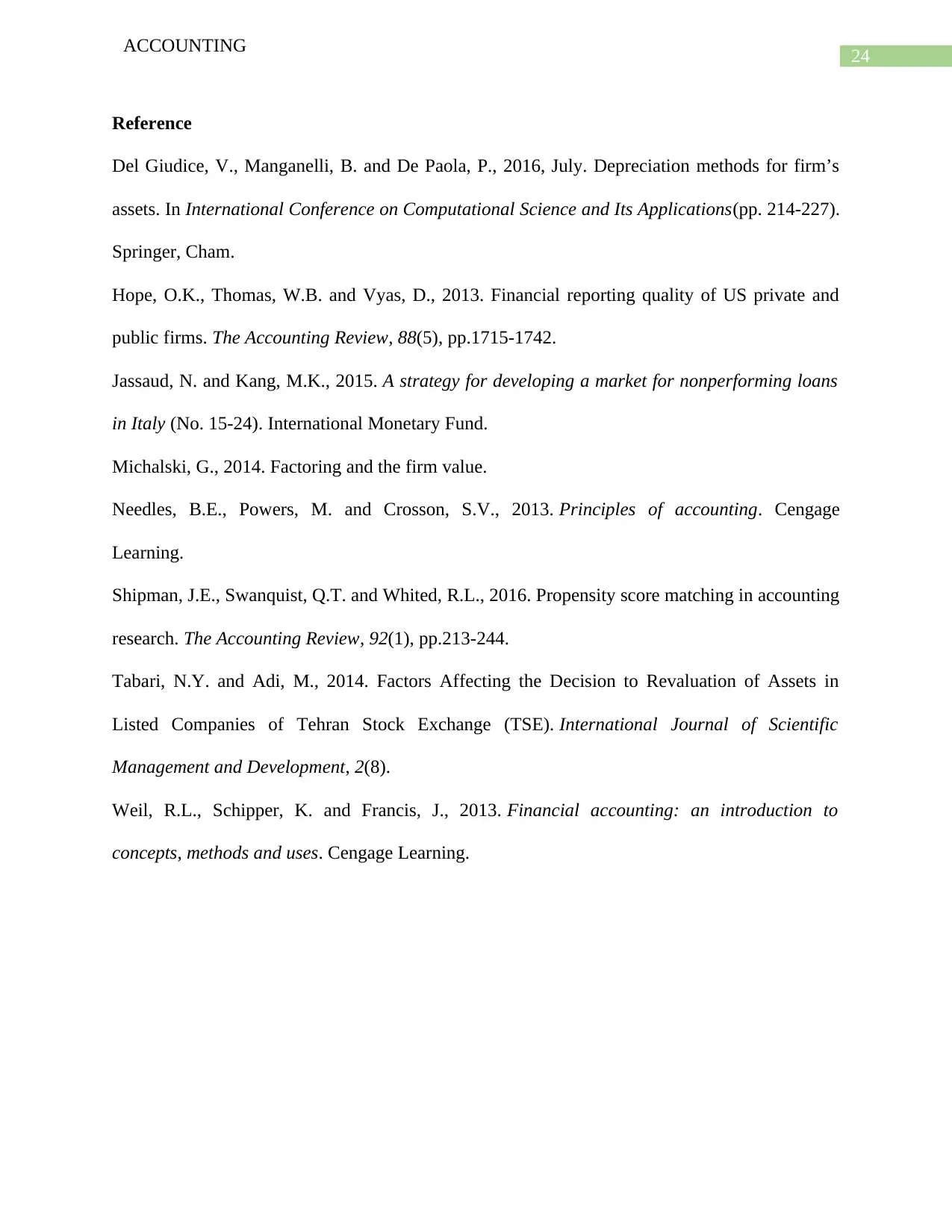
24
ACCOUNTING
Reference
Del Giudice, V., Manganelli, B. and De Paola, P., 2016, July. Depreciation methods for firm’s
assets. In International Conference on Computational Science and Its Applications(pp. 214-227).
Springer, Cham.
Hope, O.K., Thomas, W.B. and Vyas, D., 2013. Financial reporting quality of US private and
public firms. The Accounting Review, 88(5), pp.1715-1742.
Jassaud, N. and Kang, M.K., 2015. A strategy for developing a market for nonperforming loans
in Italy (No. 15-24). International Monetary Fund.
Michalski, G., 2014. Factoring and the firm value.
Needles, B.E., Powers, M. and Crosson, S.V., 2013. Principles of accounting. Cengage
Learning.
Shipman, J.E., Swanquist, Q.T. and Whited, R.L., 2016. Propensity score matching in accounting
research. The Accounting Review, 92(1), pp.213-244.
Tabari, N.Y. and Adi, M., 2014. Factors Affecting the Decision to Revaluation of Assets in
Listed Companies of Tehran Stock Exchange (TSE). International Journal of Scientific
Management and Development, 2(8).
Weil, R.L., Schipper, K. and Francis, J., 2013. Financial accounting: an introduction to
concepts, methods and uses. Cengage Learning.
ACCOUNTING
Reference
Del Giudice, V., Manganelli, B. and De Paola, P., 2016, July. Depreciation methods for firm’s
assets. In International Conference on Computational Science and Its Applications(pp. 214-227).
Springer, Cham.
Hope, O.K., Thomas, W.B. and Vyas, D., 2013. Financial reporting quality of US private and
public firms. The Accounting Review, 88(5), pp.1715-1742.
Jassaud, N. and Kang, M.K., 2015. A strategy for developing a market for nonperforming loans
in Italy (No. 15-24). International Monetary Fund.
Michalski, G., 2014. Factoring and the firm value.
Needles, B.E., Powers, M. and Crosson, S.V., 2013. Principles of accounting. Cengage
Learning.
Shipman, J.E., Swanquist, Q.T. and Whited, R.L., 2016. Propensity score matching in accounting
research. The Accounting Review, 92(1), pp.213-244.
Tabari, N.Y. and Adi, M., 2014. Factors Affecting the Decision to Revaluation of Assets in
Listed Companies of Tehran Stock Exchange (TSE). International Journal of Scientific
Management and Development, 2(8).
Weil, R.L., Schipper, K. and Francis, J., 2013. Financial accounting: an introduction to
concepts, methods and uses. Cengage Learning.
1 out of 25
Related Documents
Your All-in-One AI-Powered Toolkit for Academic Success.
+13062052269
info@desklib.com
Available 24*7 on WhatsApp / Email
![[object Object]](/_next/static/media/star-bottom.7253800d.svg)
Unlock your academic potential
© 2024 | Zucol Services PVT LTD | All rights reserved.





